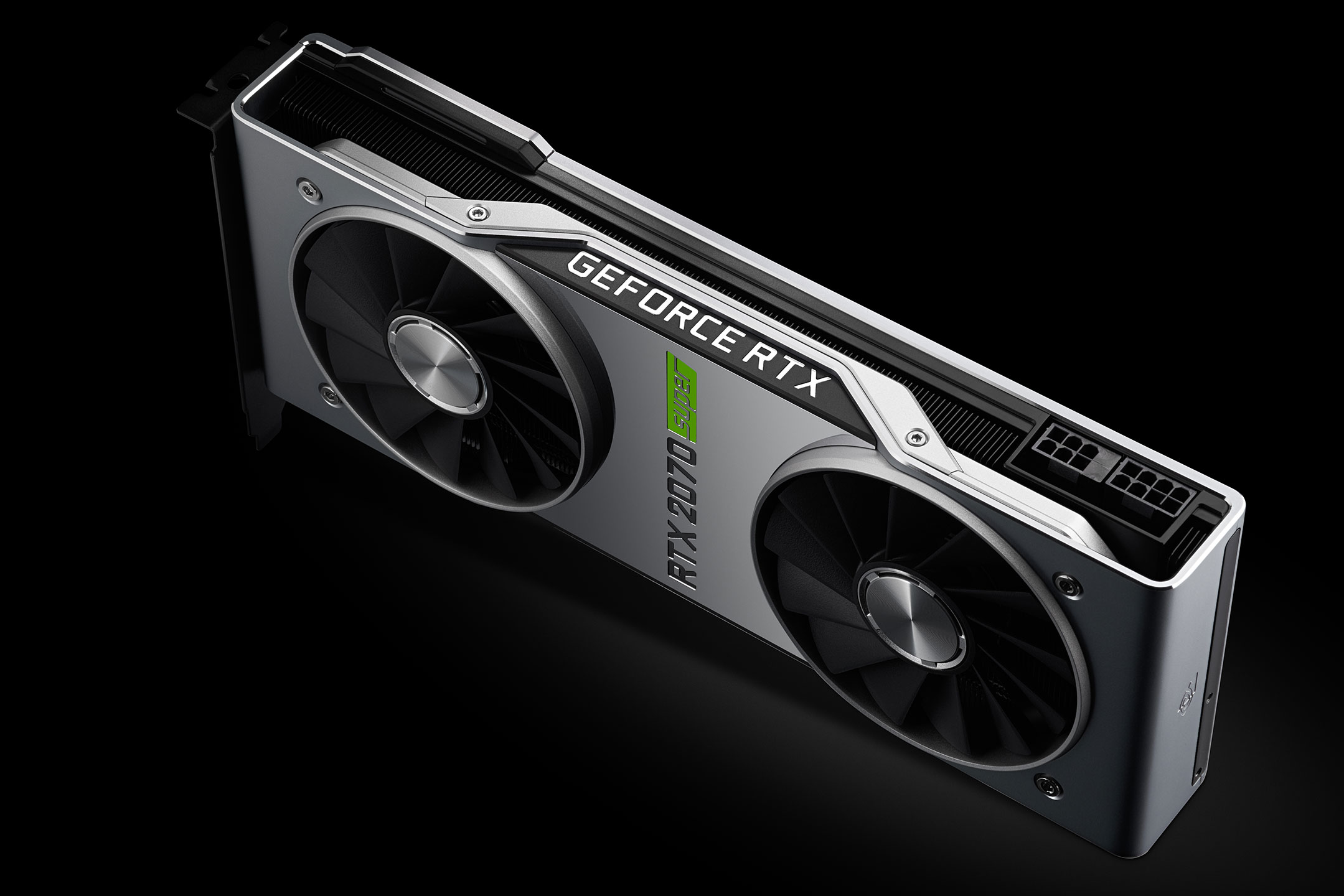Our Verdict
The GeForce RTX 2070 Super is everything that was good about the 2070, plus about 10-15 percent more performance, at the same price.
For
- Close to a 2080 for less money
- No more Founders Edition premium
- All the same Turing features
Against
- Only slightly faster than RTX 2070 FE
- Nothing new to see here
- Needs a killer RTX game
PC Gamer's got your back
Today's launch of the Nvidia GeForce RTX 2070 Super was entirely predictable. AMD's Navi architecture and the Radeon RX 5700 and RX 5700 XT are slated to launch on July 7, joining the ranks of the best graphics cards. AMD is also claiming the 5700 XT will be about 10 percent faster than the RTX 2070 and will cost $50 less. Nine months after the RTX 2070 initially went on sale, yields have likely improved and Nvidia now has a reason to improve performance. The result is the RTX 2070 Super, moving up to the TU104 GPU with additional cores and performance, but keeping the 2070's official starting price of $499—there's no longer a $599 Founders Edition premium.
Silly branding aside (seriously, 'Super' was the best name Nvidia could come up with?), there's not much new to report. The GeForce RTX 2070 Super uses the same Turing architecture as the existing RTX cards, and the short summary is that additional CUDA cores and higher clockspeeds make it faster than the outgoing RTX 2070. Unlike the vanilla RTX 2060, which will remain on sale even though there's now a GeForce RTX 2060 Super, the vanilla 2070 and 2080 cards are being phased out. So much for AMD's 10 percent performance advantage over the 2070.
Here's what the revised RTX lineup looks like.
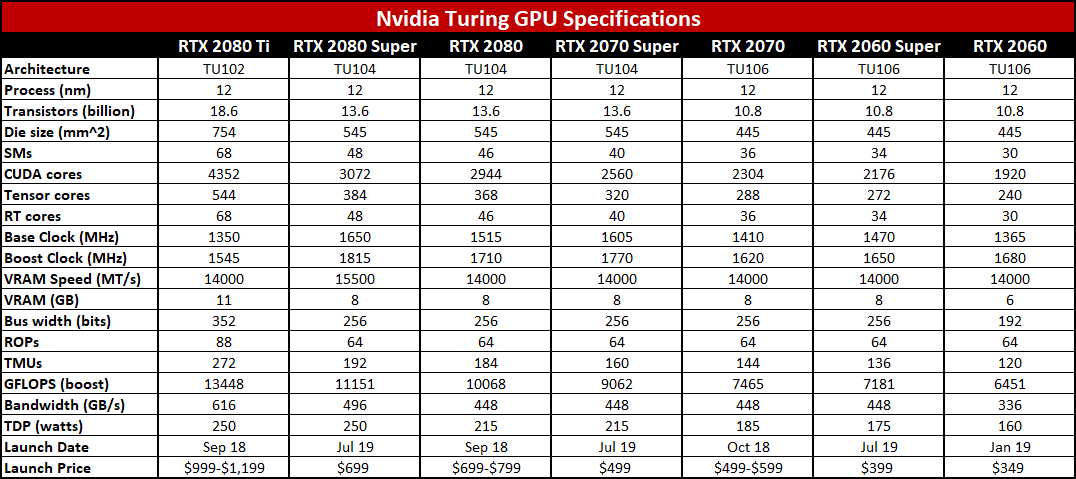
The 2060 Super has the advantage of being able to add more memory and thus increase bandwidth relative to the vanilla 2060. The GeForce RTX 2070 already uses a fully enabled TU106 chip, which means Nvidia needs to look elsewhere if it's going to improve performance by adding more cores. And 'elsewhere' in this case means moving up to the larger TU104 chip that's also in the RTX 2080.
The GeForce RTX 2070 Super comes with 40 SMs (streaming multiprocessors), and each SM contains 1 RT core, 8 Tensor cores, 4 texture units, and 64 CUDA cores. (FP64 performance is 1/32 FP32 performance, as with the other GeForce RTX cards.) Basically, the 2070 Super is like a trimmed down RTX 2080.
The RTX 2070 Super reference boost clock is 1770MHz, which is higher than even the overclocked 2070 Founders Edition boost clock of 1710MHz. That combined with the additional four SMs means performance is theoretically up to 22 percent faster than the RTX 2070. But theory and real-world results don't always agree. Since the 2070 Super has the same memory bandwidth and configuration, in practice the performance improvement often ends up being closer to 10-15 percent.
The good news is that any added performance relative to the RTX 2070 comes without an increase in price. Even the 2070 Super Founders Edition sticks with a base price of $499. Of course, RTX 2070 cards have gone on sale for as little as $450 over the past nine months, but we'll probably see the Super cards sell for less than the launch price at some point. And the arrival of the 2070 Super also heralds the phasing out of the regular 2070. Those cards will probably remain available for many months yet, but eventually the 2070 Super—and 2080 Super—will be the only RTX 2070/2080 cards still being manufactured, so they'll replace the base models on our best graphics cards run-down.
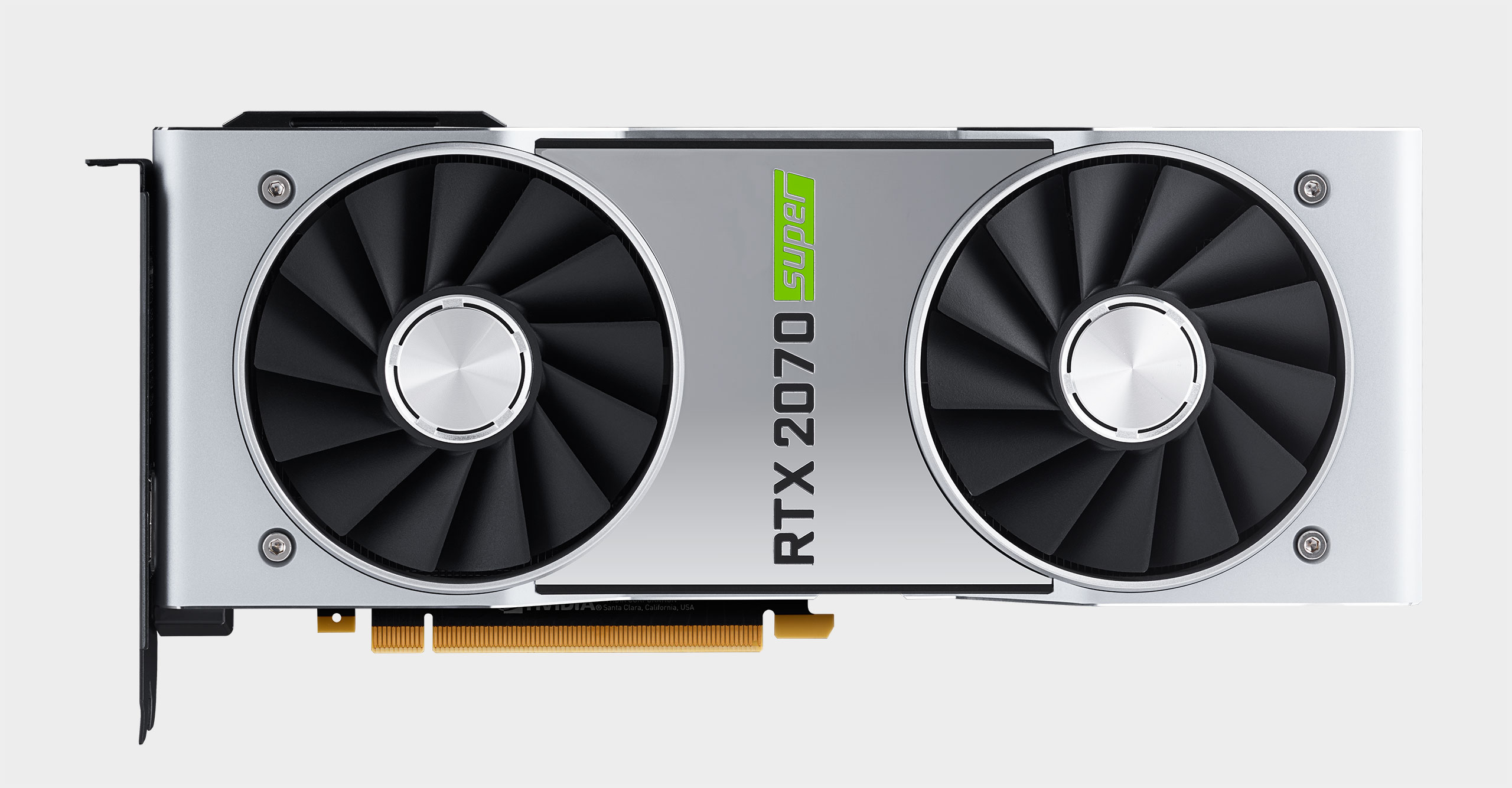
You can see the full specs for our GPU test bed on the right. We use a Core i7-8700K overclocked to 5.0GHz to ensure the CPU isn't a bottleneck in our testing. It doesn't matter much with slower graphics cards, but for cards as fast as the RTX 2070 Super, we don't want anything holding the GPU back. We also use DDR4-3200 memory and fast SSD storage for the same reason.
We've benchmarked using the latest drivers available at the time of testing, including retesting older GPUs to ensure our results are up to date. All Nvidia GPUs were tested with the 430.86 drivers, except for the two Super cards which used 431.16 (because there's simply not enough hours in the day to retest every GPU with the launch drivers Nvidia provided). For AMD, we used the 19.16.2 drivers.
As I note in the RTX 2060 Super review, while the list of games I'm testing has been updated, I'm not using DXR or DLSS for any of these benchmarks. That's to provide a meaningful comparison between the various GPUs, though I've tested games with DXR and DLSS support elsewhere. AMD for now doesn't even support DXR via compute shaders, so until Navi 20 arrives sometime in the future, Nvidia GPUs remain the only option for DXR-enabled games.
I'm testing with 11 games that include a pretty even mix of AMD and Nvidia promoted titles. DirectX 12 is utilized in most cases, with the exception of Total War: Warhammer 2 where the "DX12 Beta" performance is particularly weak on Nvidia GPUs. Each card is tested at four settings: 1080p medium (or equivalent) and 1080p/1440p/4k ultra (unless otherwise noted). Every setting is tested multiple times to ensure the consistency of the results, and we use the best score. Minimum FPS is calculated by summing all frametimes above the 97 percentile and dividing by the number of frames, so that it gives a reasonable representation of the lower end of the performance scale, rather than looking only at the single worst framerate from a benchmark run.
Here are the results, starting with 1080p. That's not normally the main target for a $500 graphics card, but if you're hoping to max out the capabilities of a 144Hz monitor, 1080p makes that easier than 1440p.
GeForce RTX 2070 Super performance
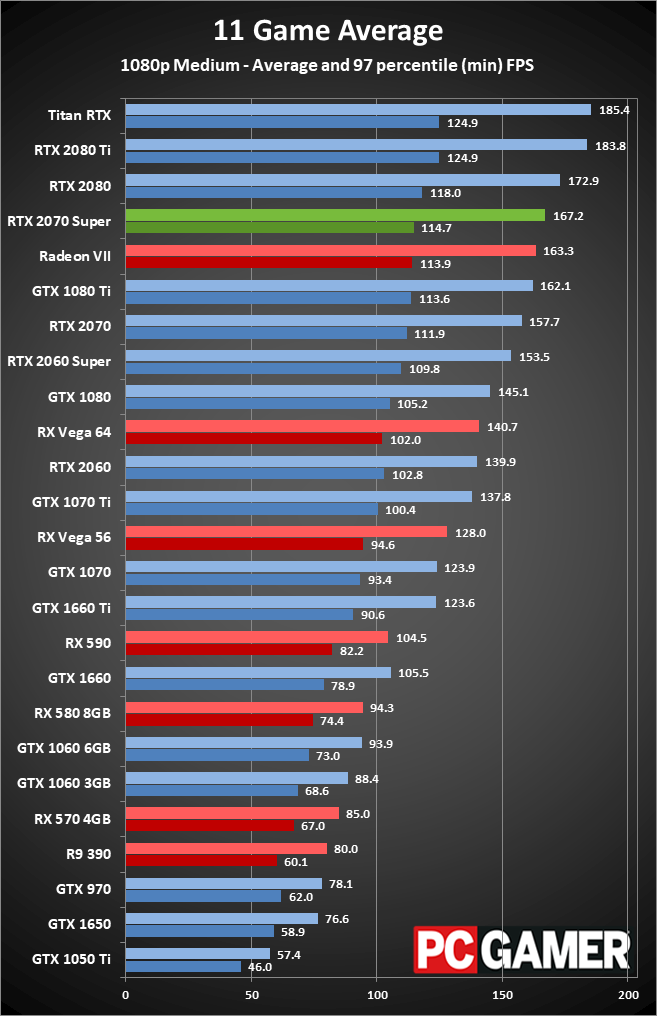
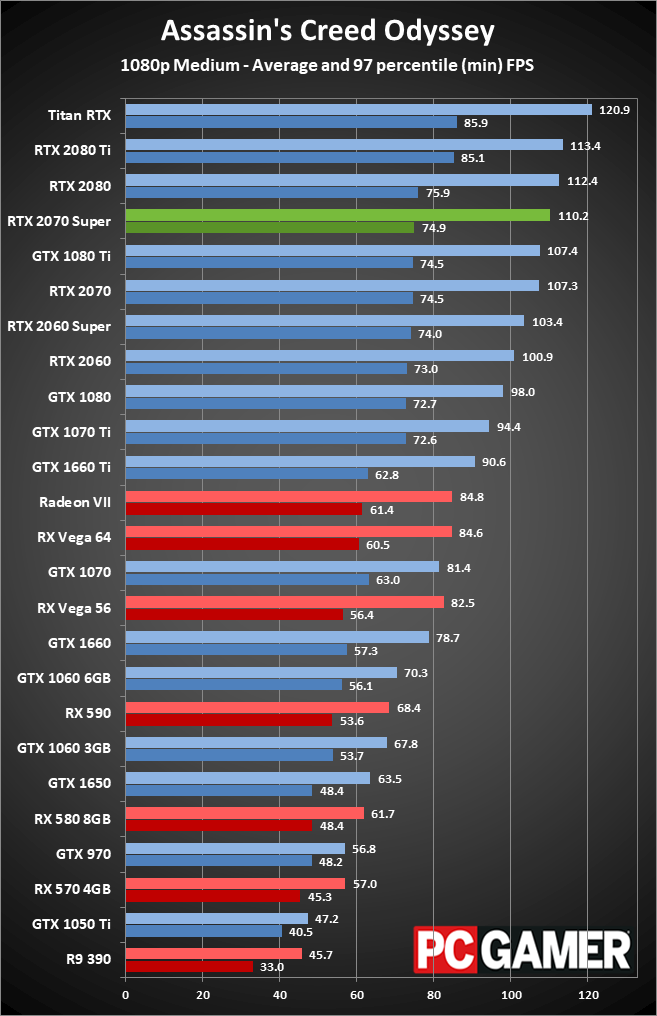
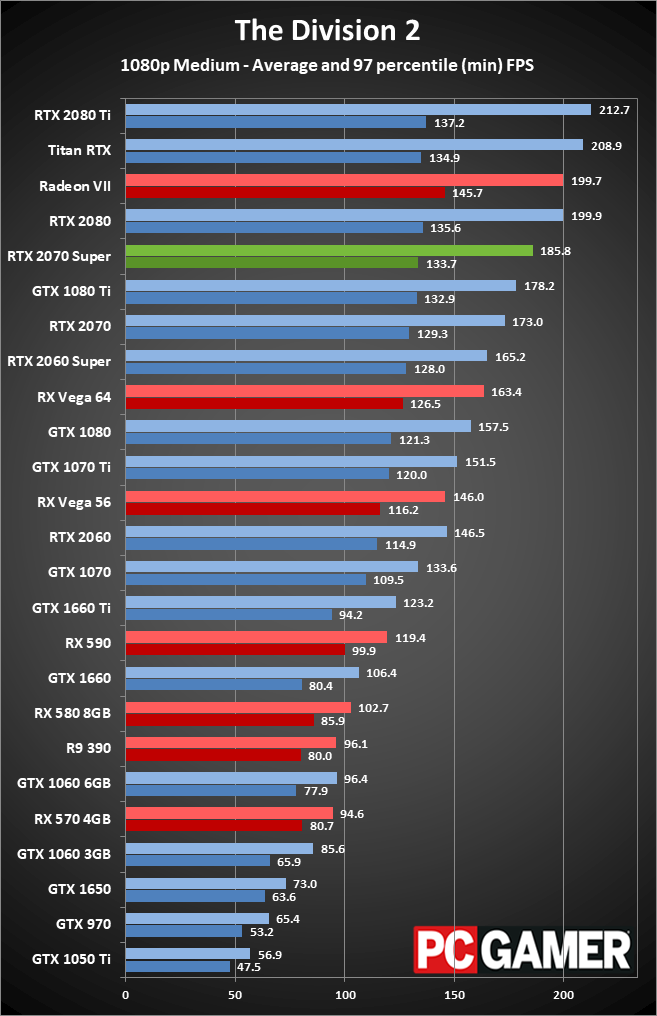

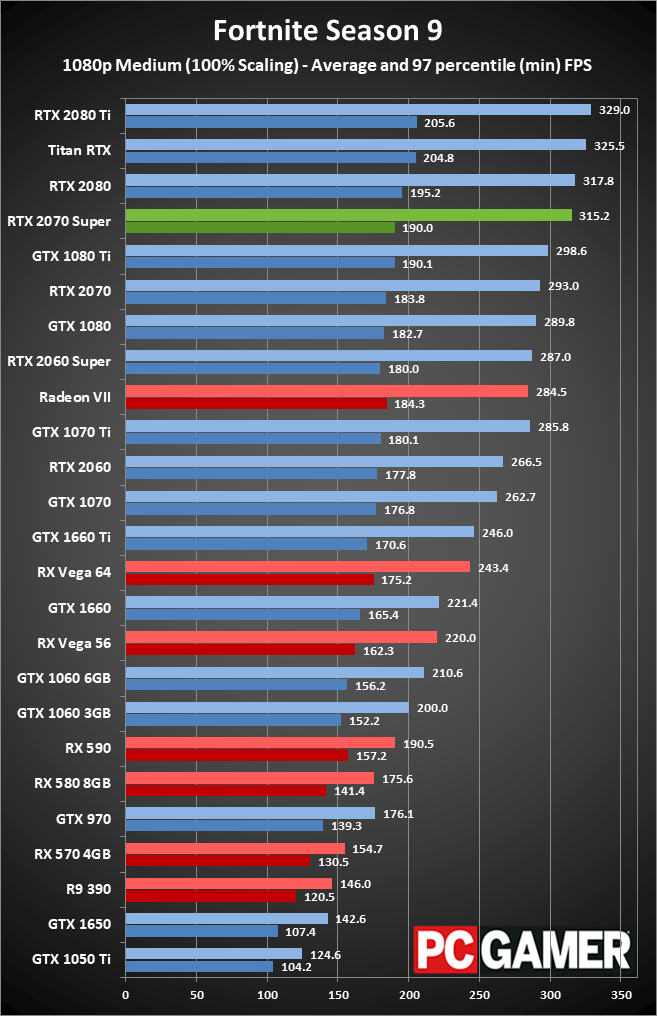
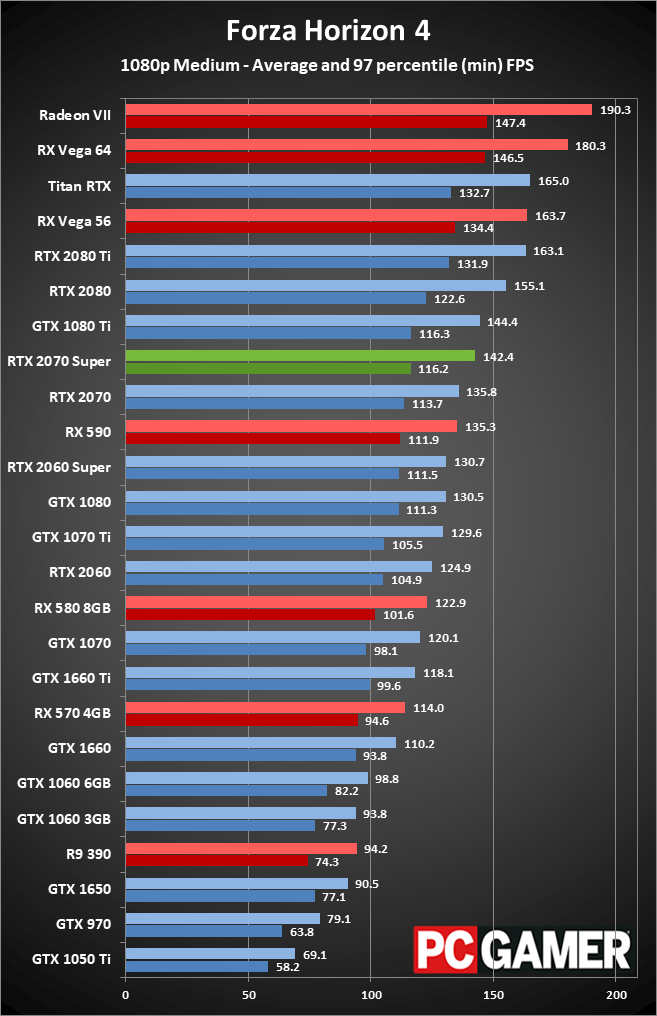
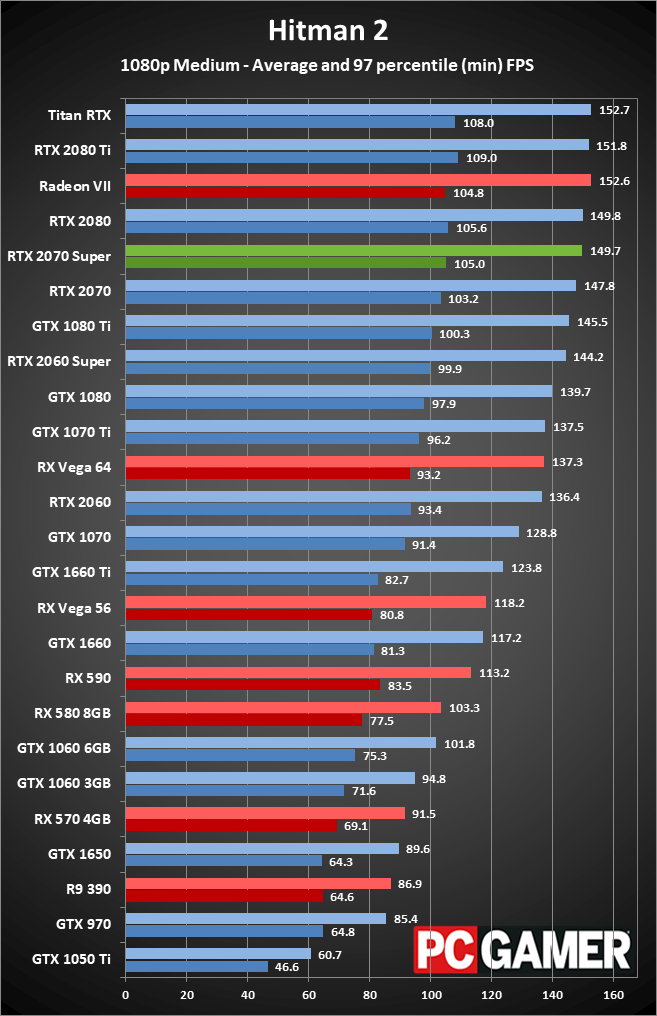
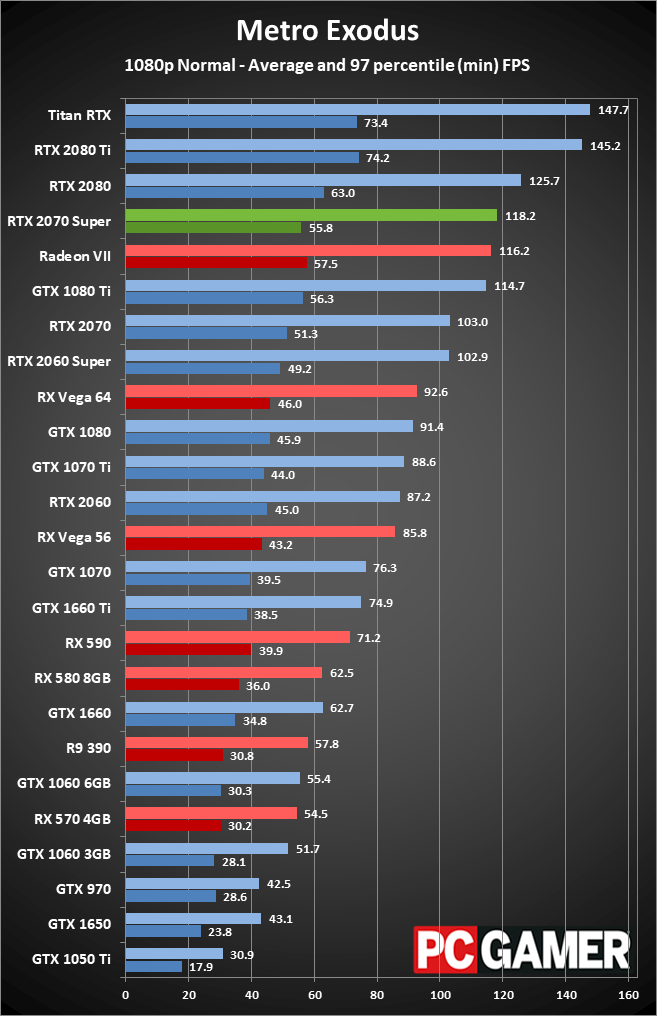
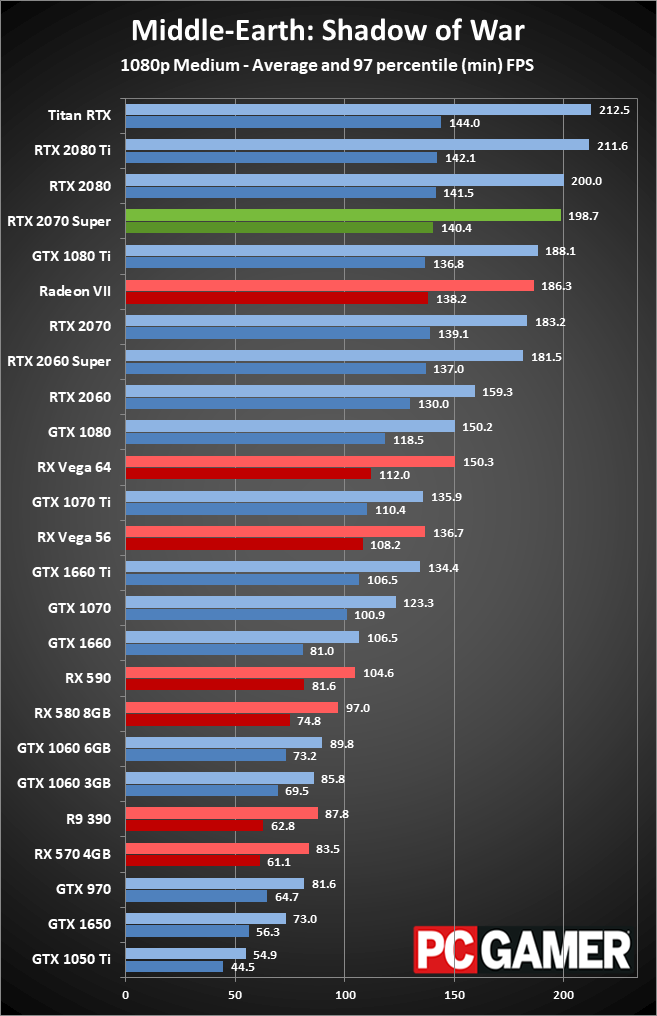
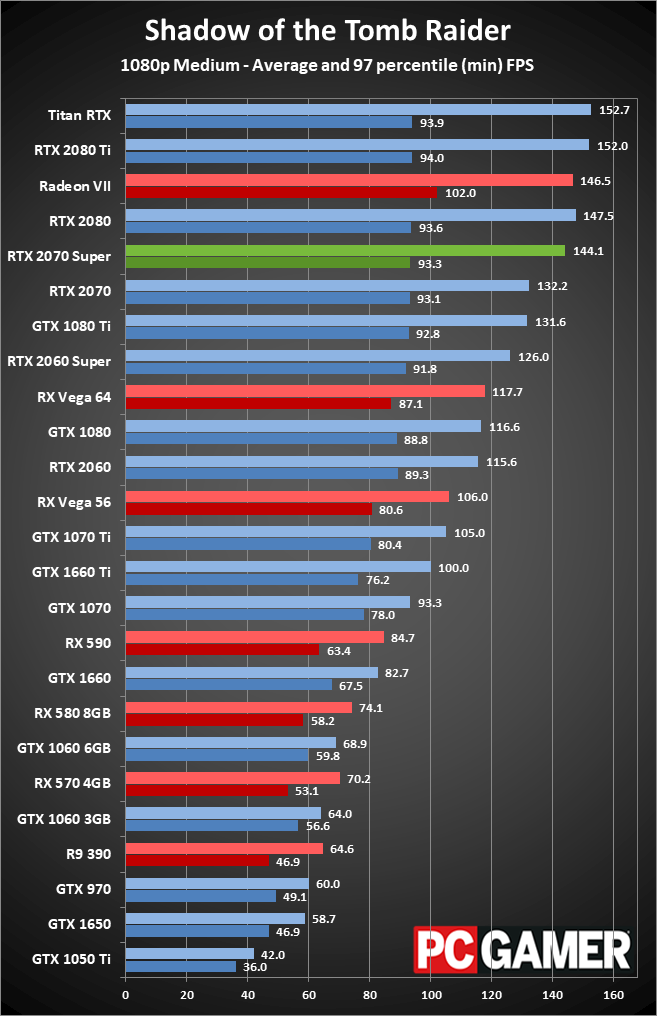
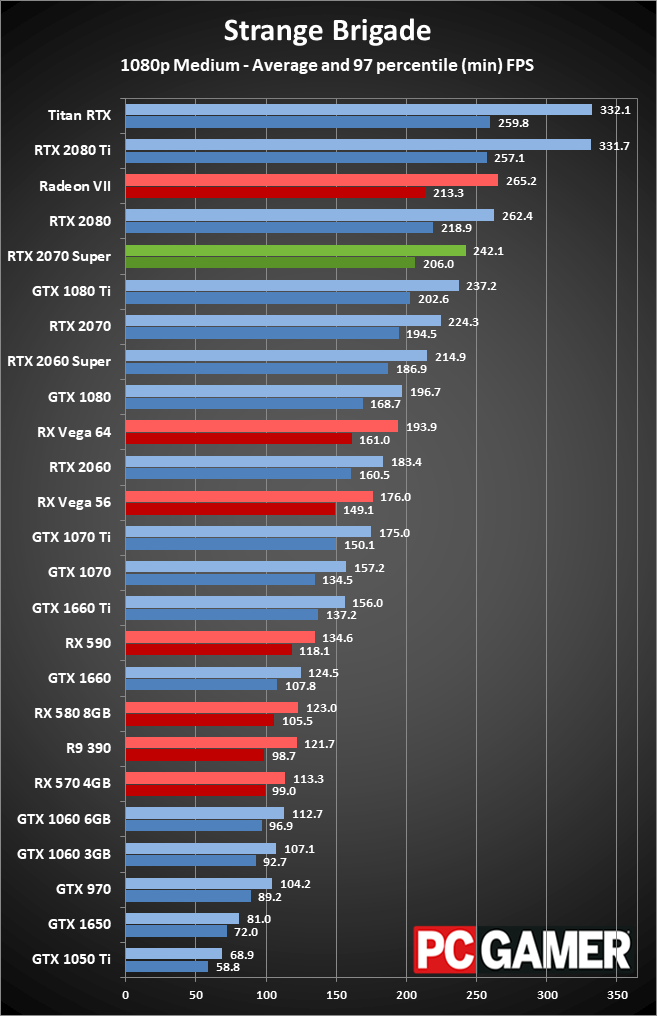
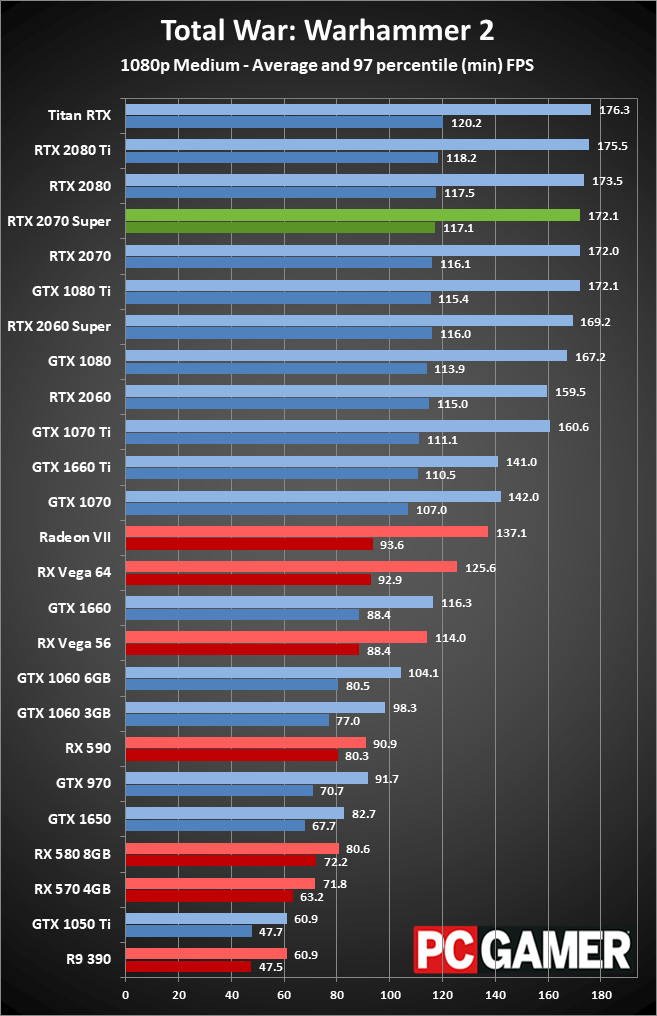
One thing to note is that I've benchmarked using Nvidia's Founders Edition cards for all of the RTX models. That makes for some slightly odd results at times since the 2070 FE, 2080 FE, and 2080 Ti FE come with a 90MHz factory overclock. The new RTX Super cards on the other hand are running reference clocks. There will almost certainly be custom Super models from Nvidia's graphics card partners that are factory overclocked, but if the 2070 Super doesn't look that much faster than the 2070, it's at least in part to the 2070 FE's overclock.
Other than that disclaimer, performance is pretty much as expected. The 2070 Super is six percent faster than the 2070 FE at 1080p medium, but many of the games are hitting CPU bottlenecks. Only the most demanding games (Assassin's Creed Odyssey and Metro Exodus—and Forza Horizon 4, though it's very close) can't reach 144fps average framerates.
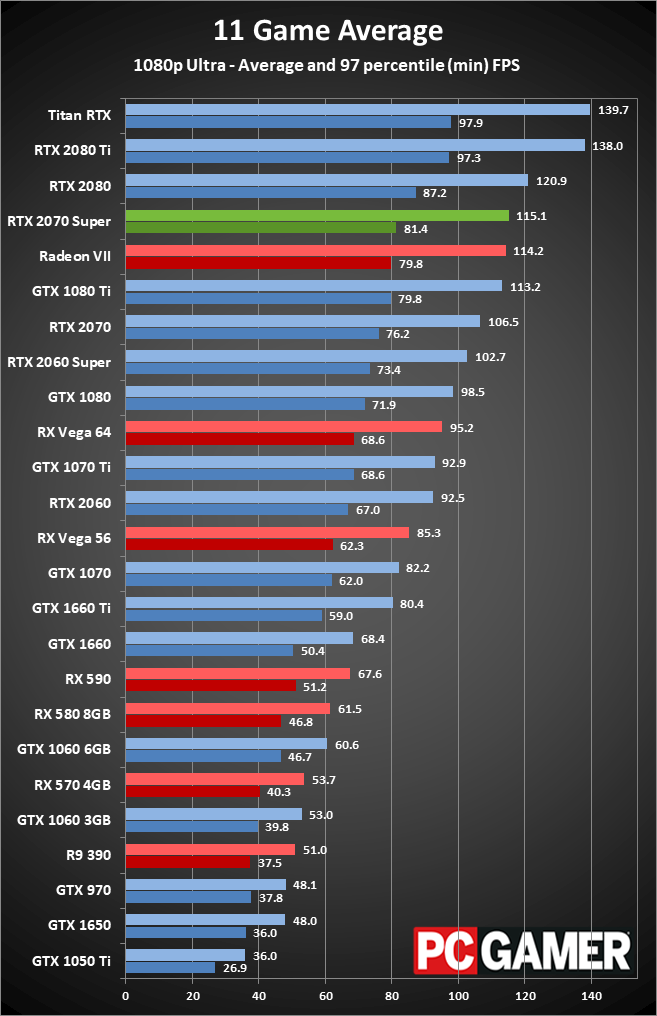
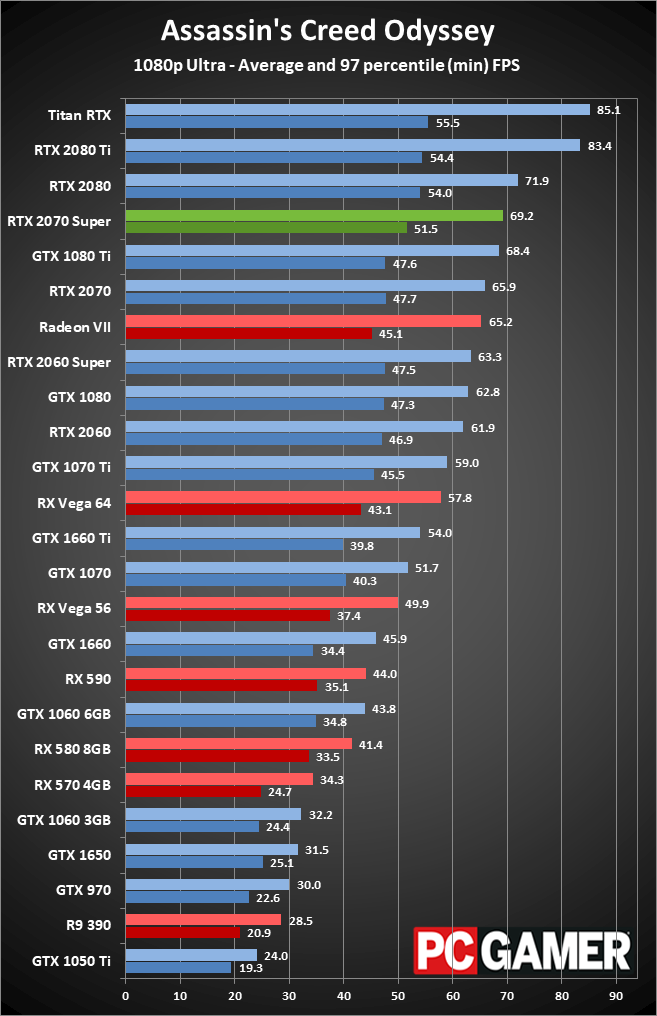

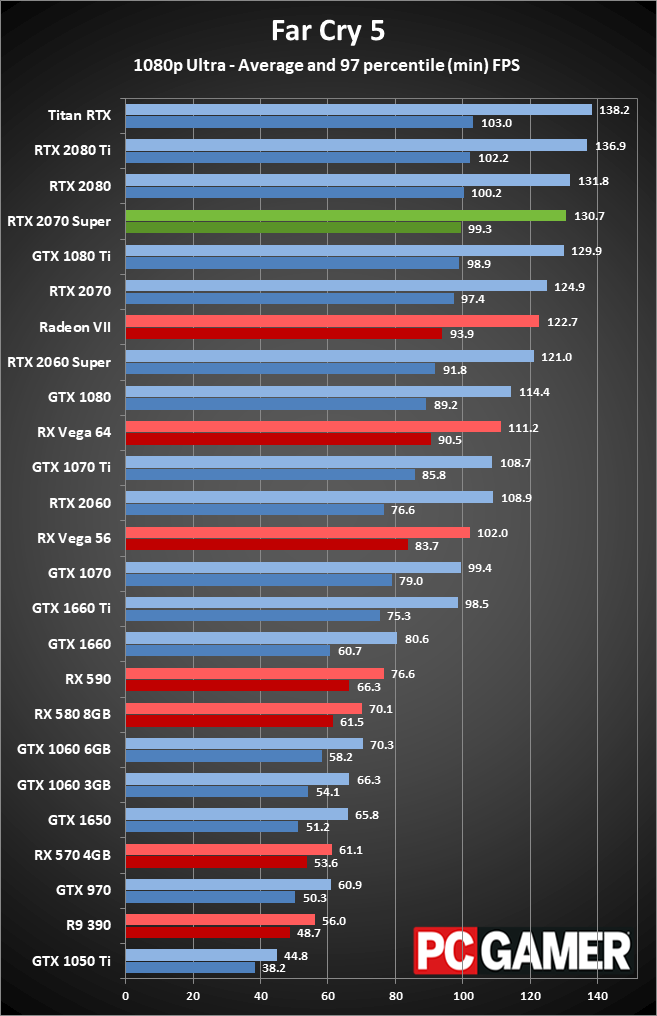
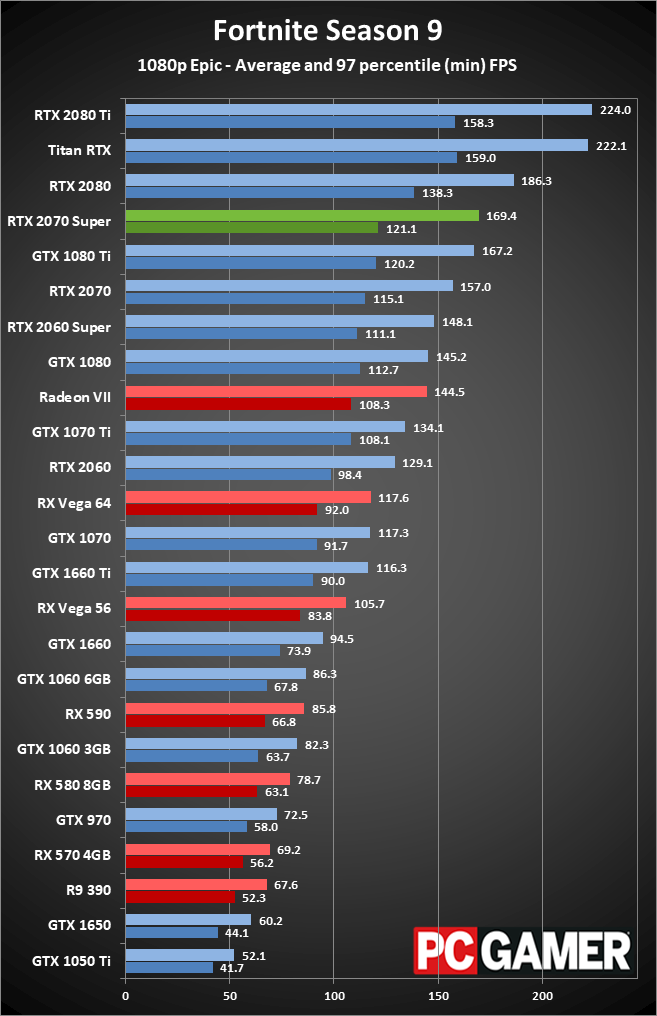
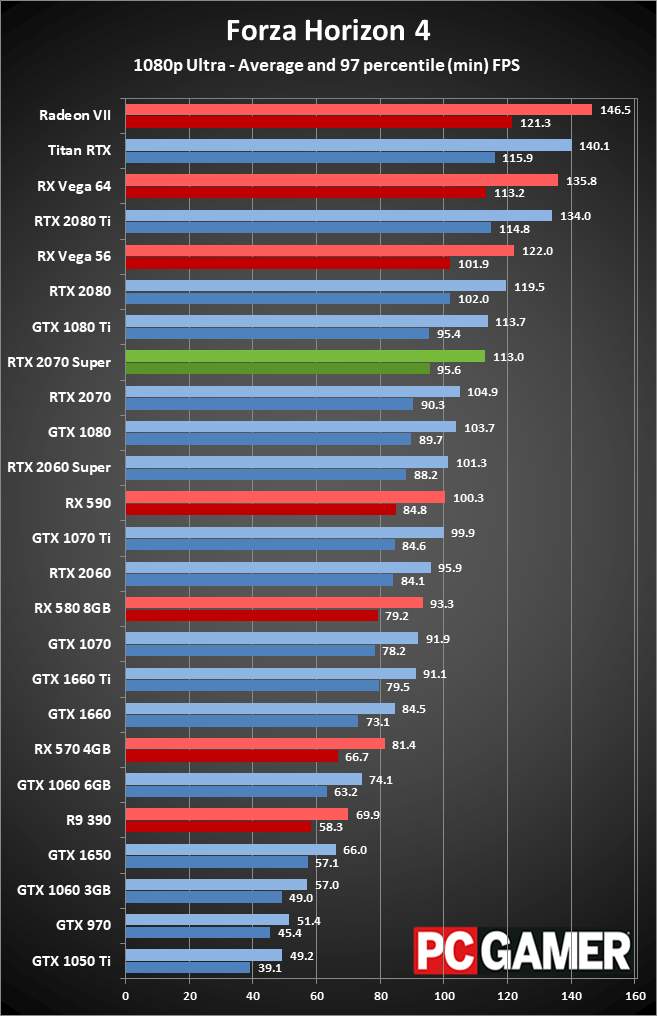
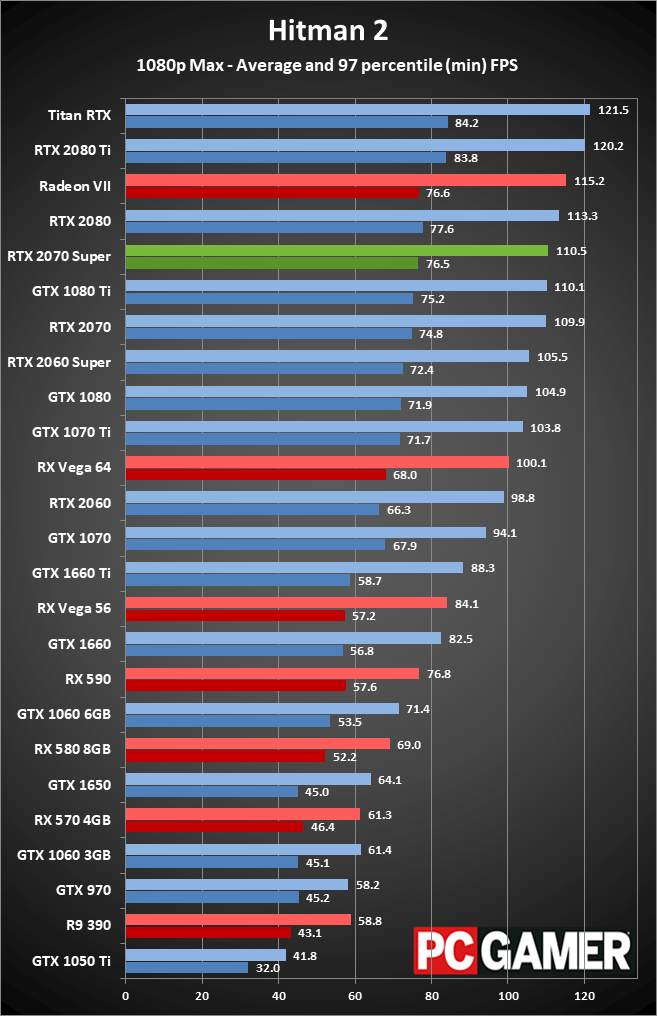
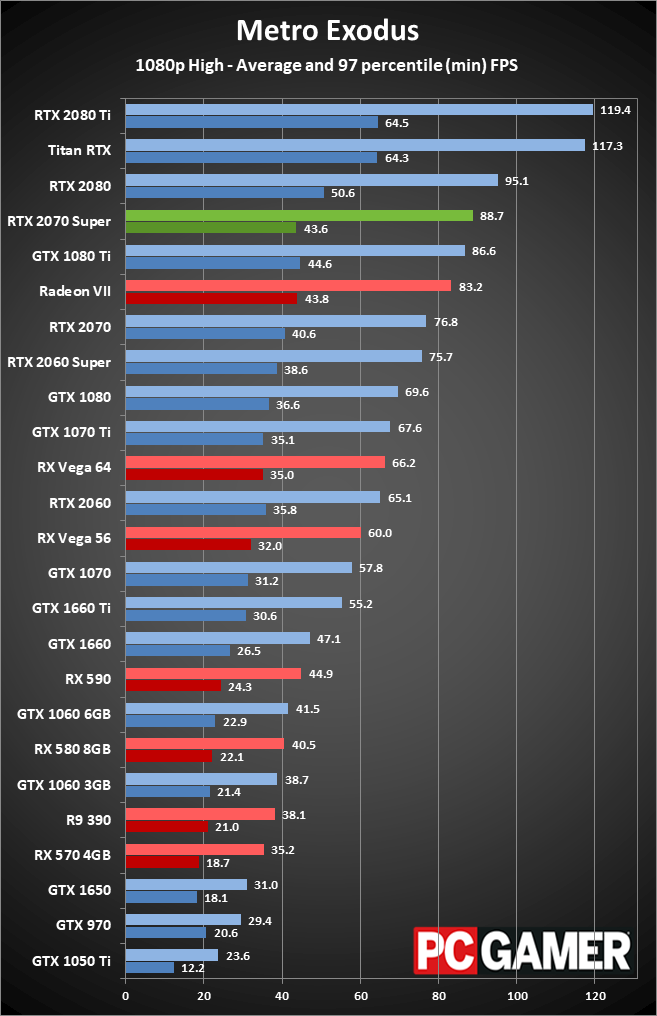
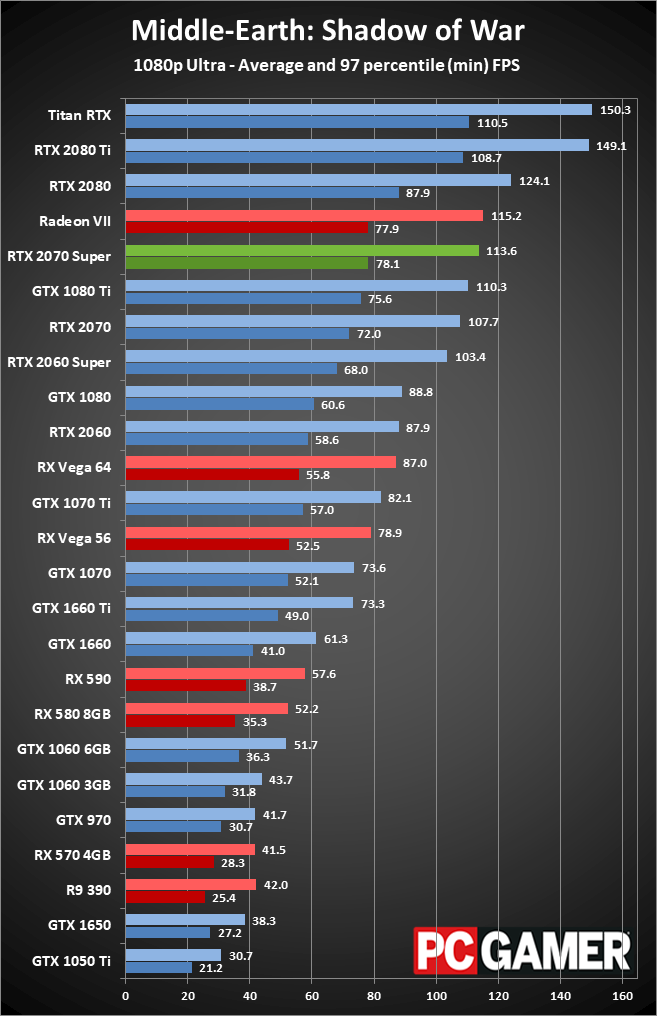
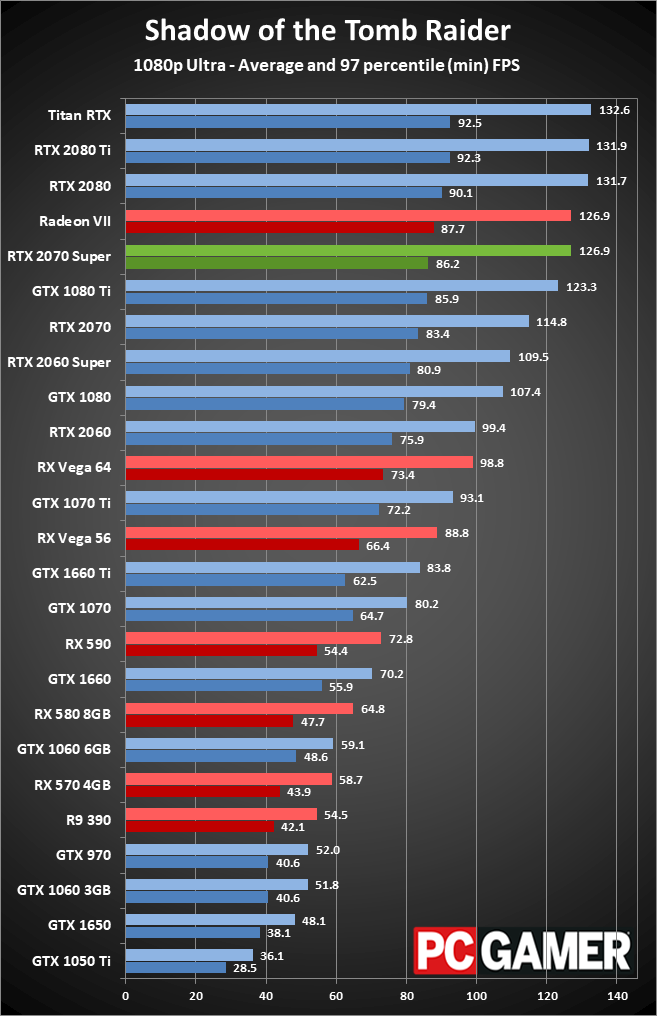
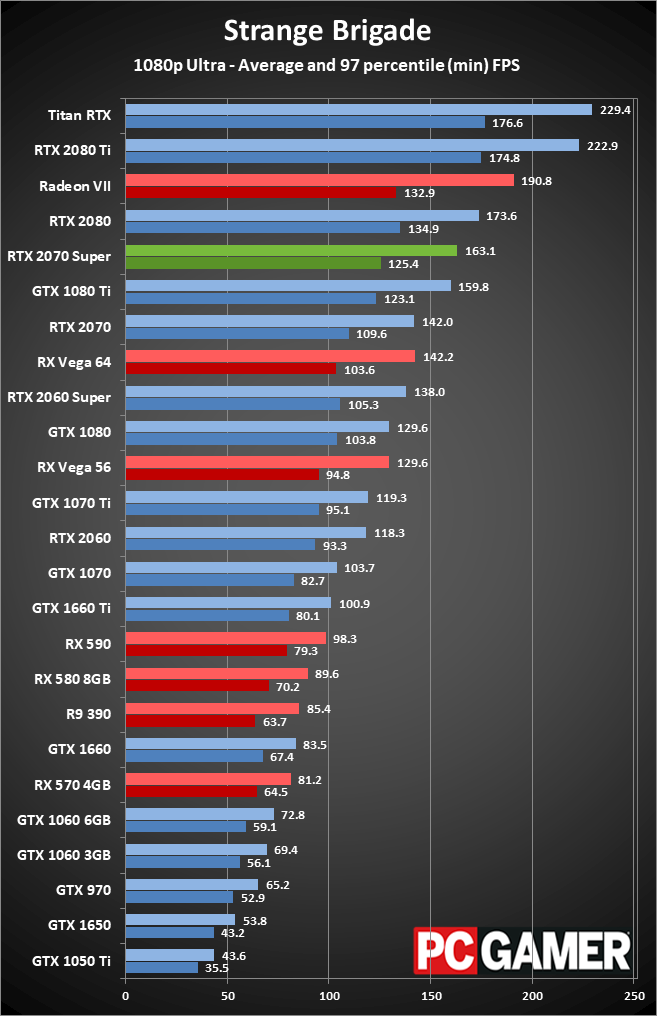
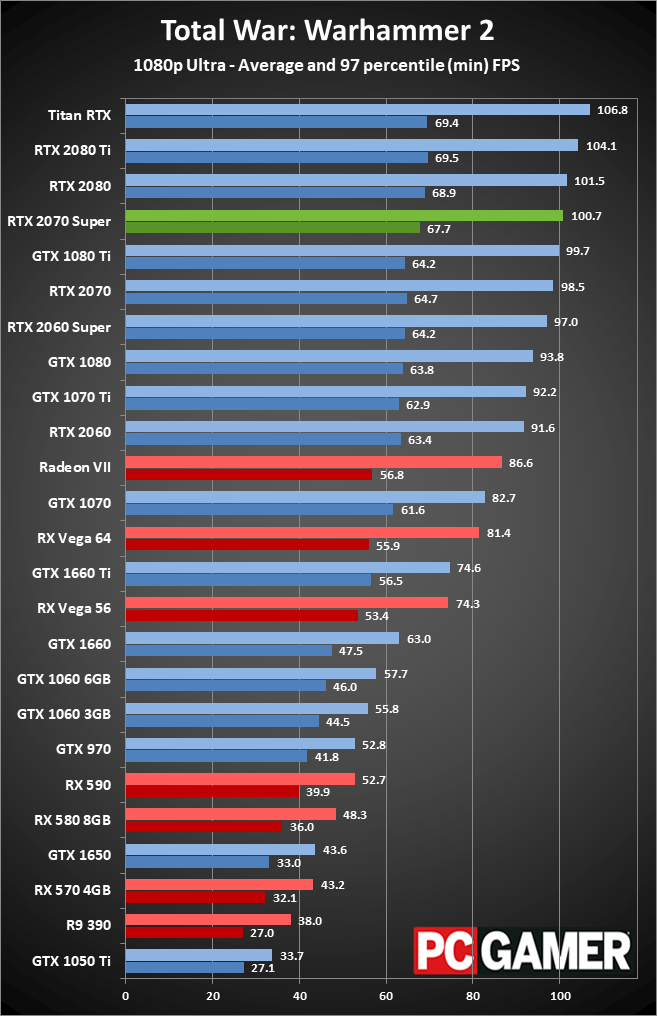
1080p ultra drops performance by about a third on average compared to 1080p medium, but the RTX 2070 Super remains comfortably above 60fps. It's also slightly faster on average than AMD's Radeon VII as well as Nvidia's GTX 1080 Ti. Compared to the 2070 FE, it's now 8 percent faster overall, which would make it about 15 percent faster than a reference clocked RTX 2070.
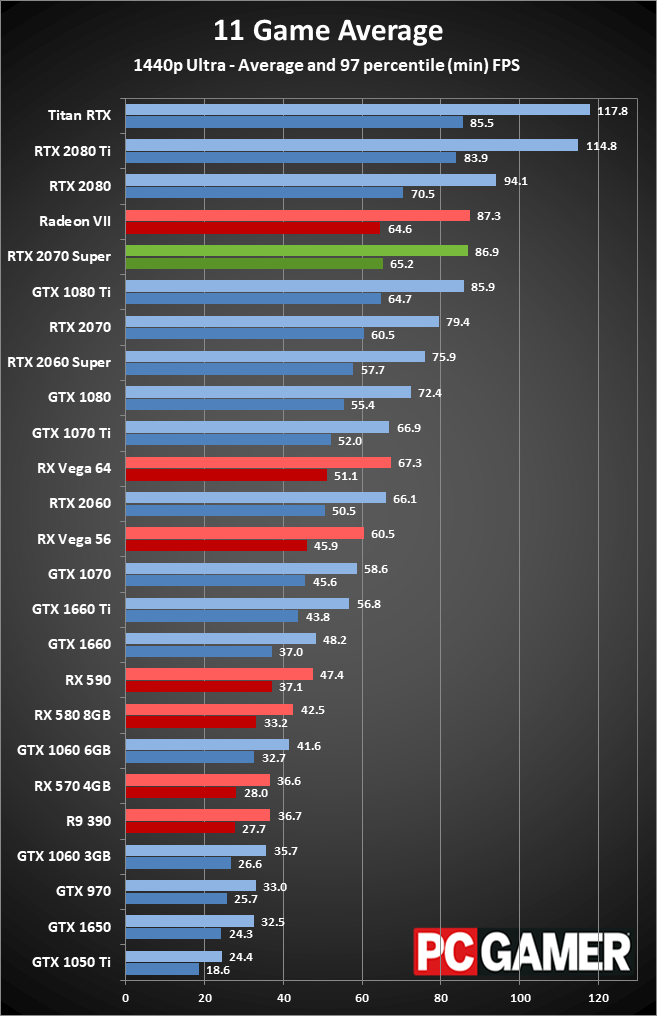
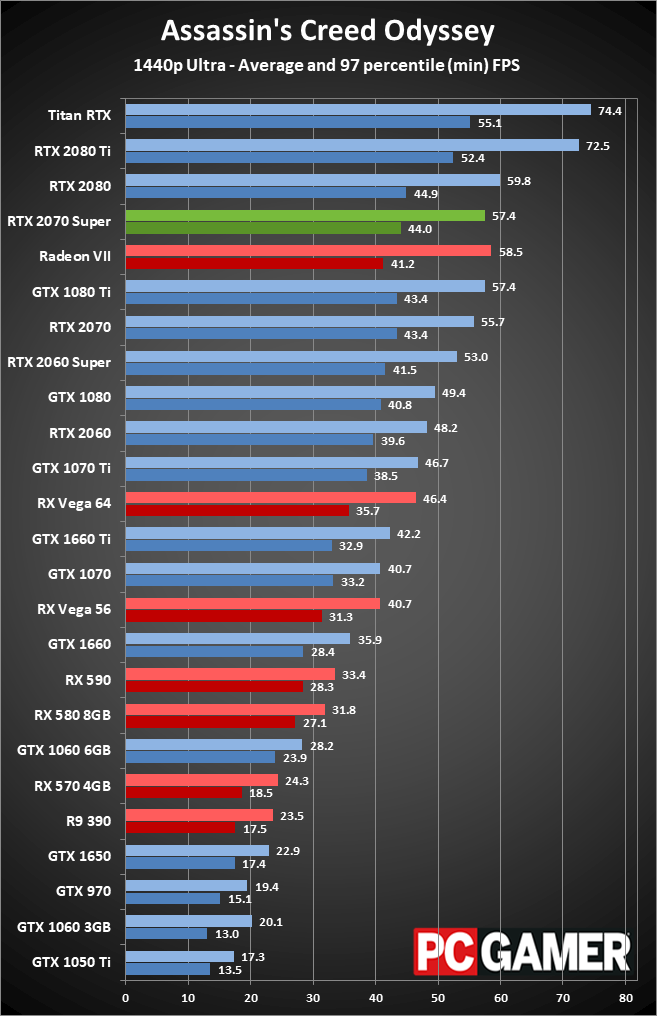
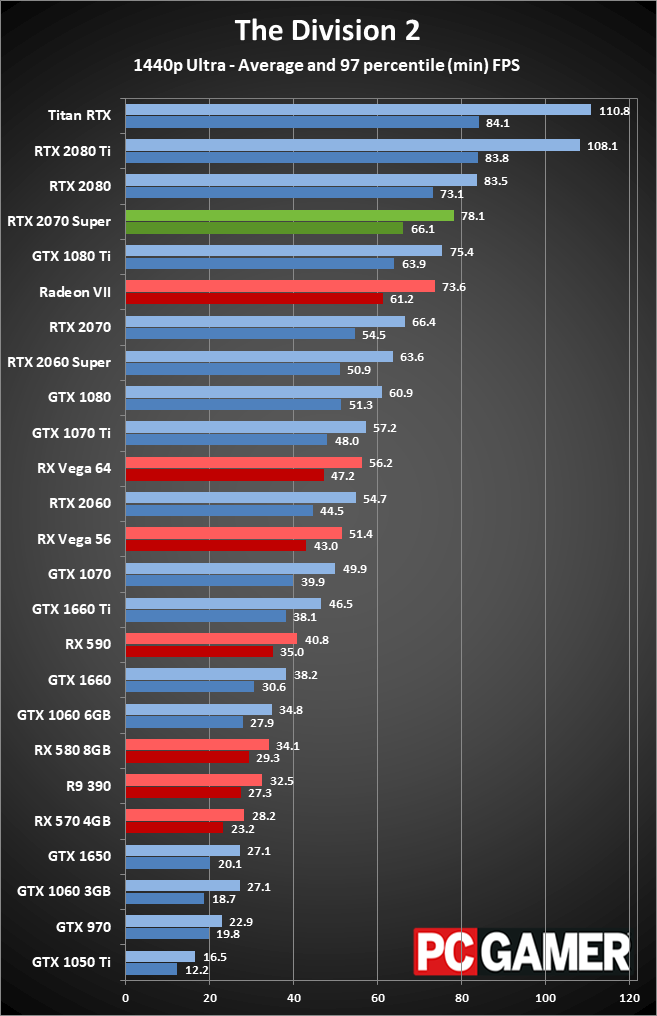
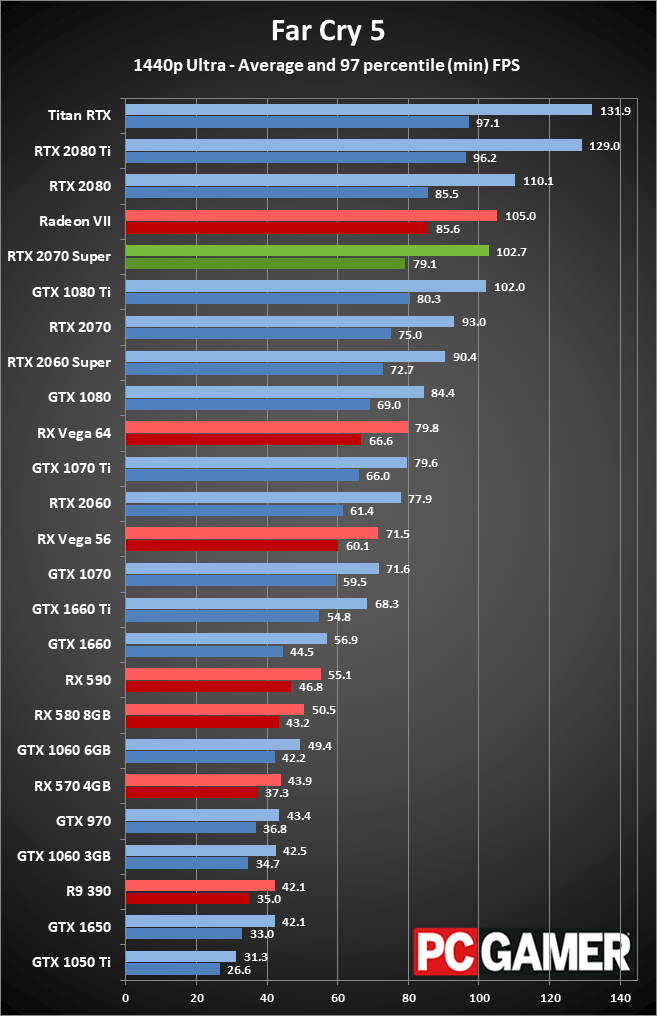
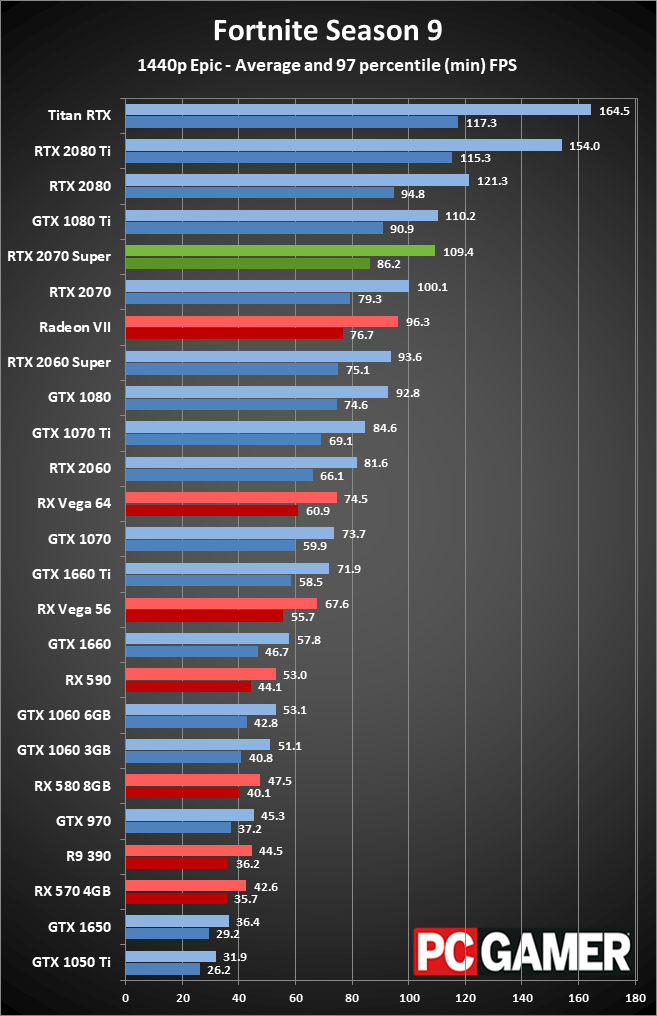
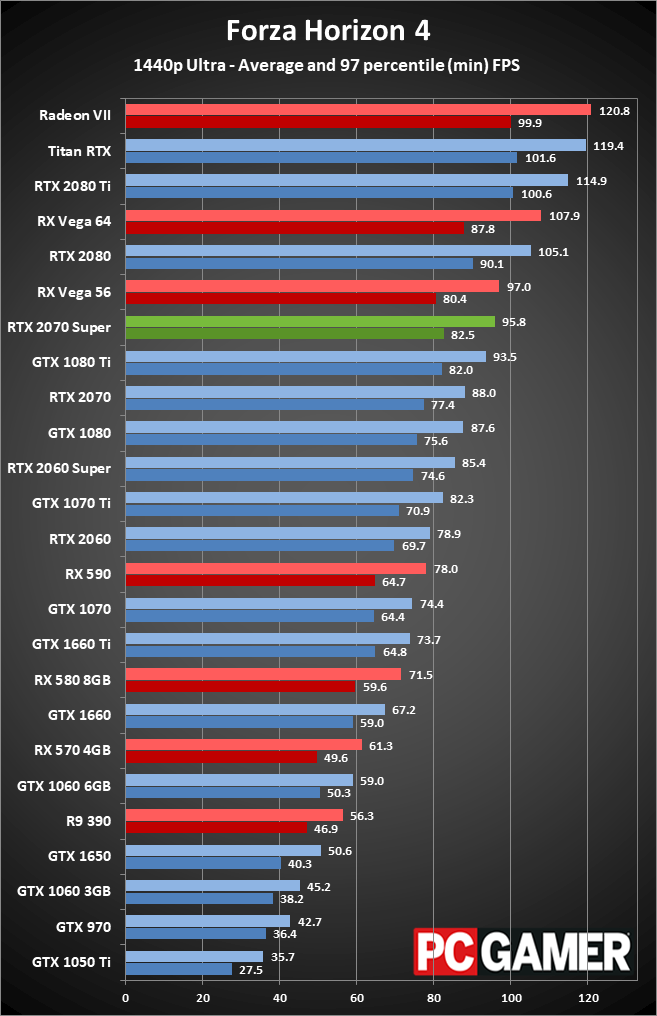
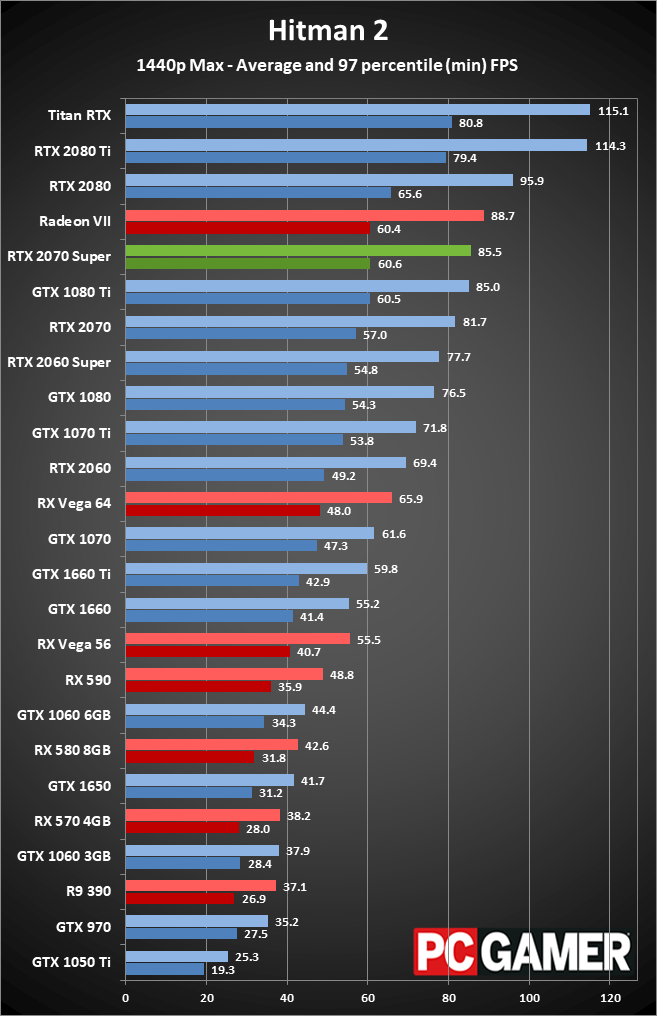
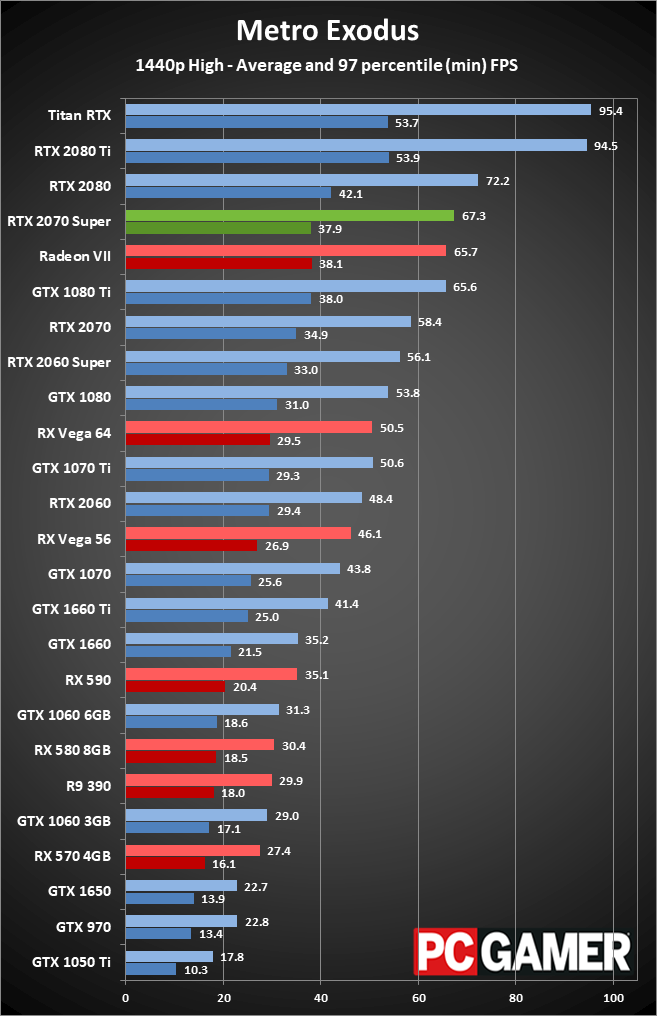
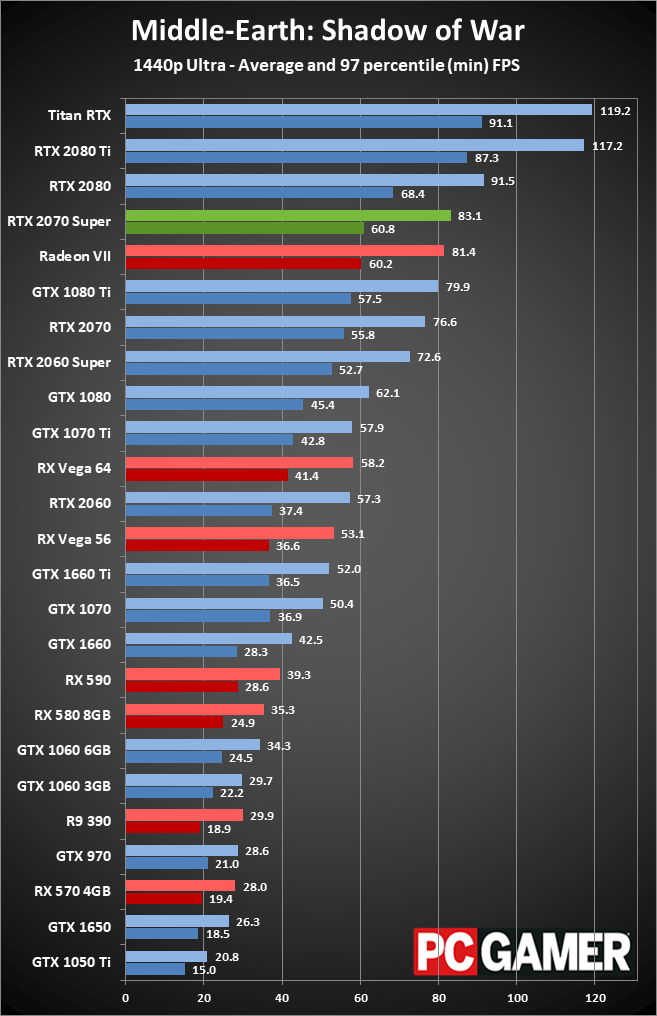
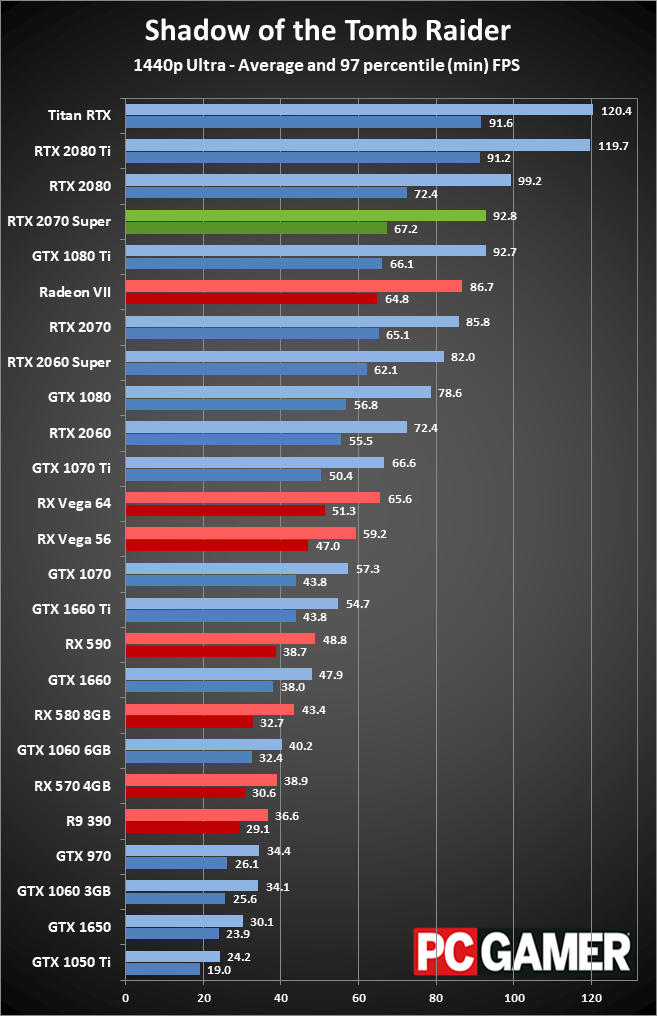
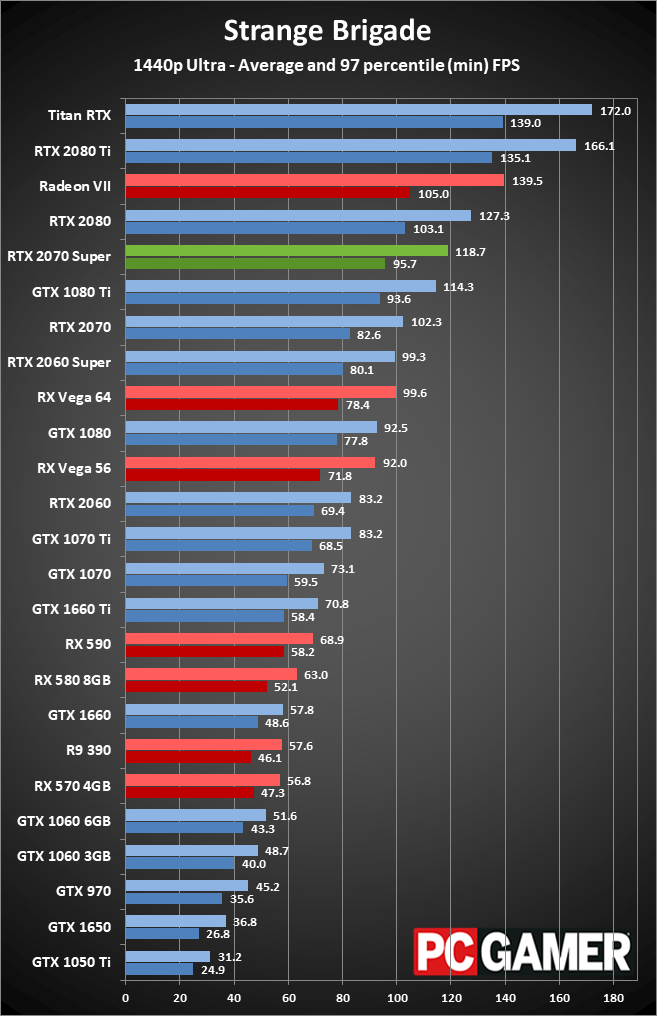
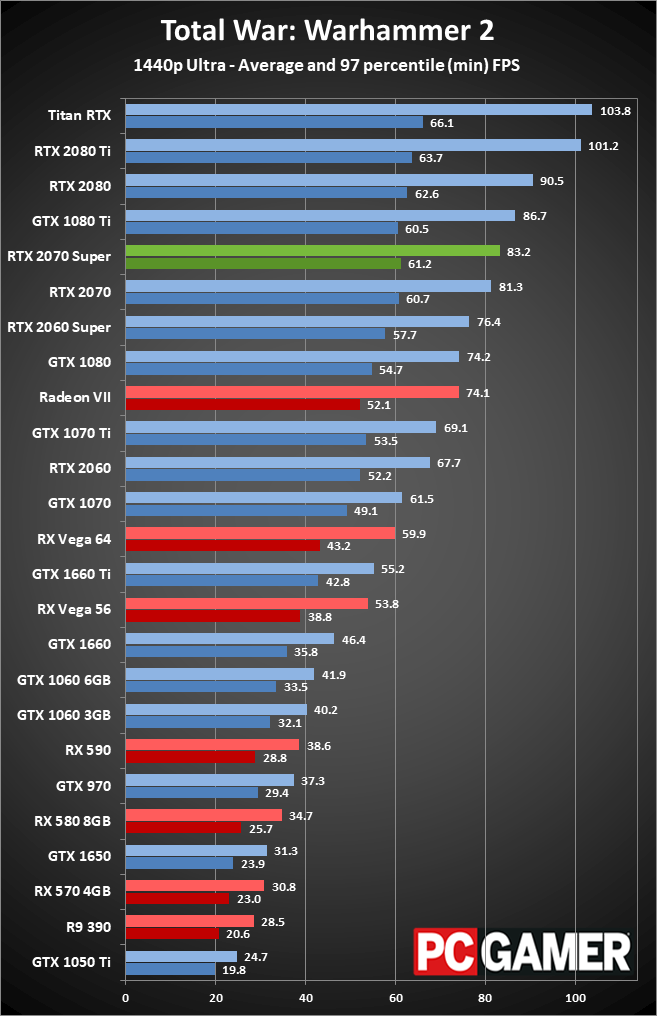
The RTX 2070 Super continues to perform well at 1440p ultra, though Assassin's Creed Odyssey would need some additional settings tuning to keep framerates above 60. The 2070 Super is now 9 percent faster than the 2070 FE, but with the higher resolution the Radeon VII now manages to come out just slightly ahead.
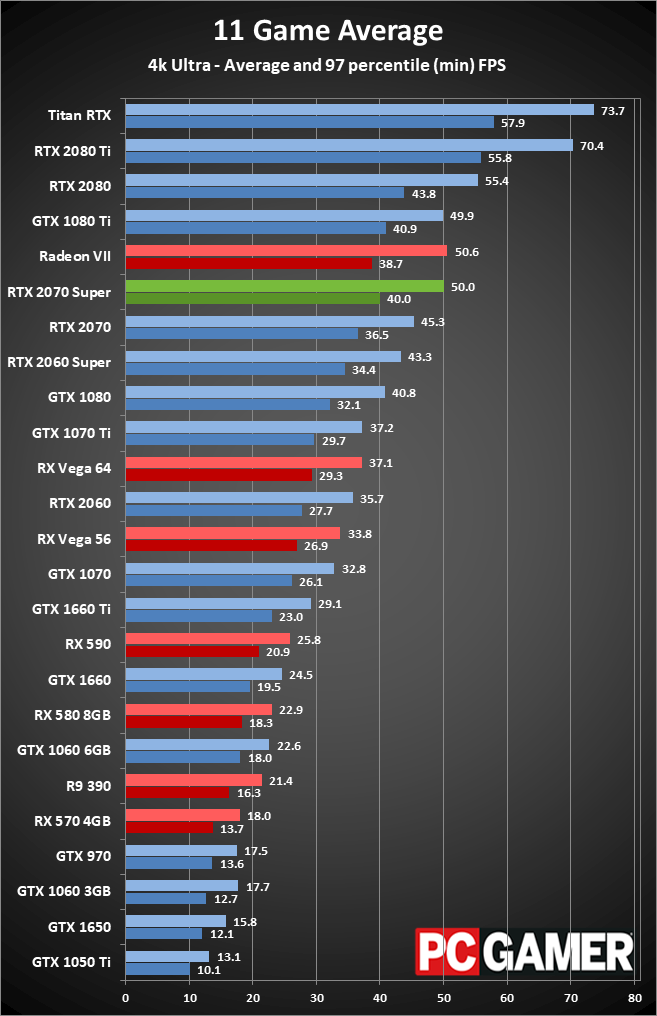
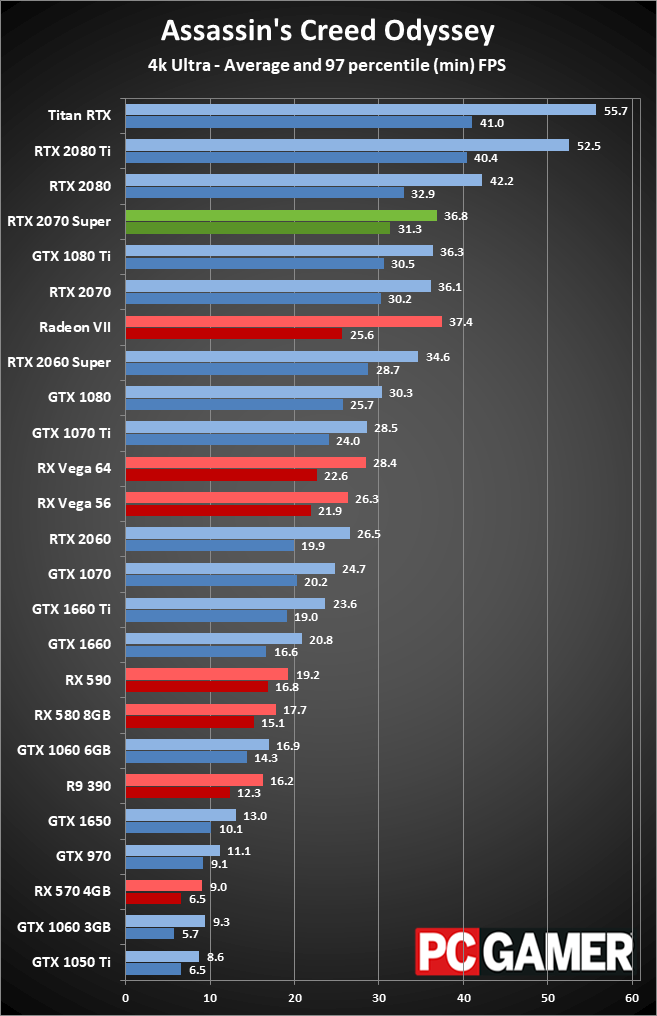
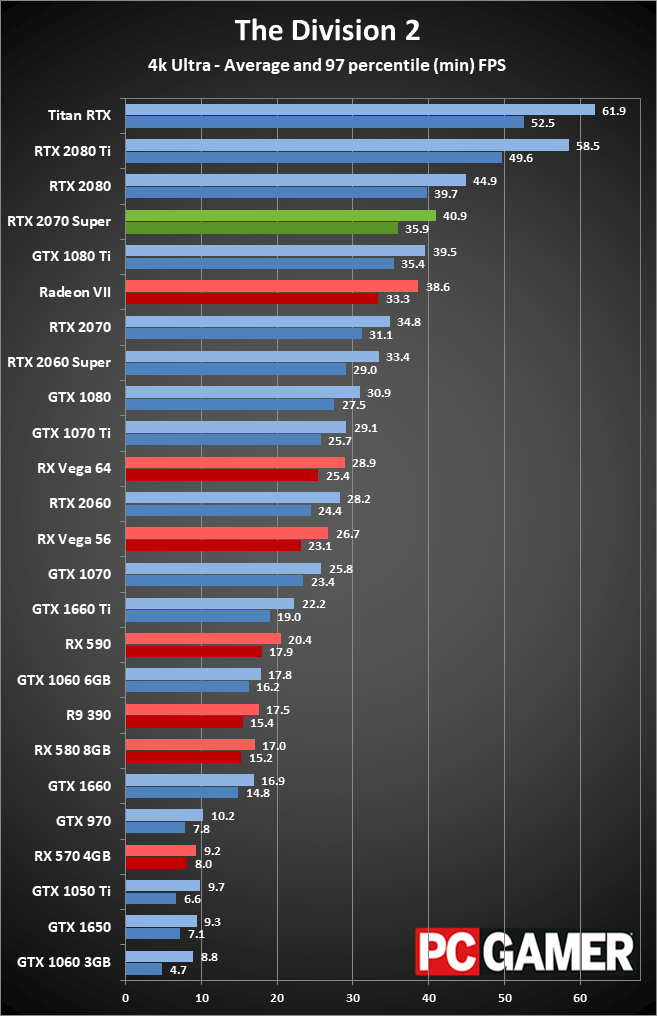
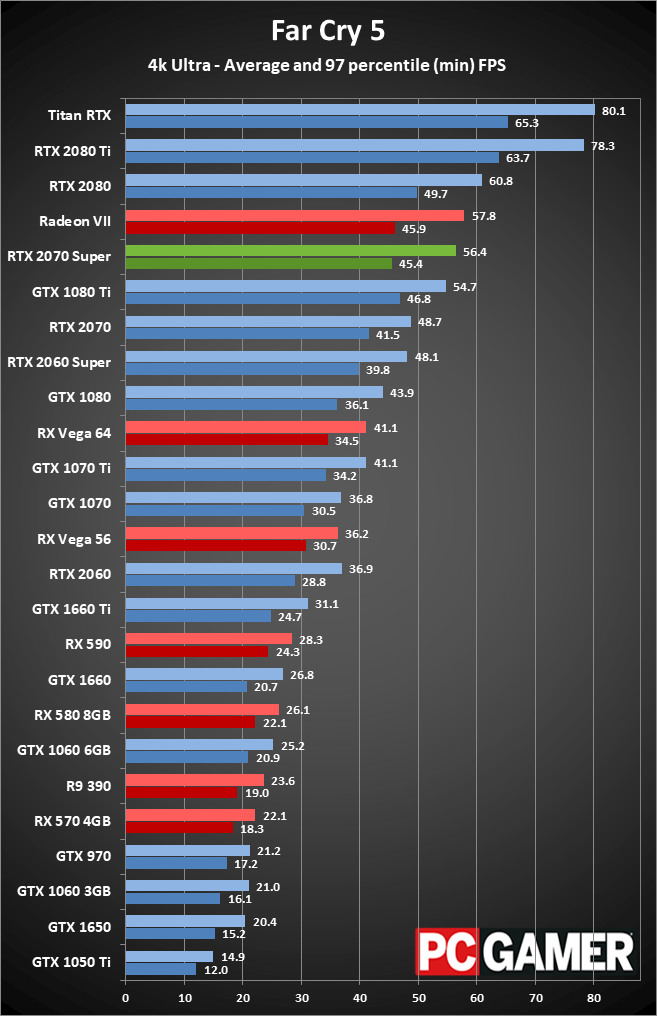
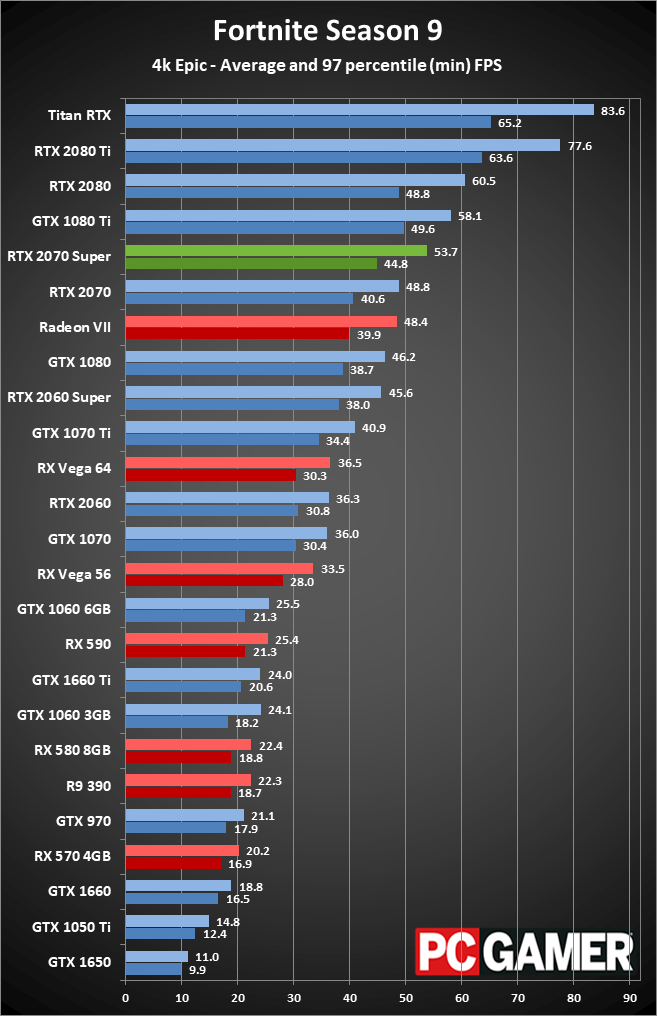
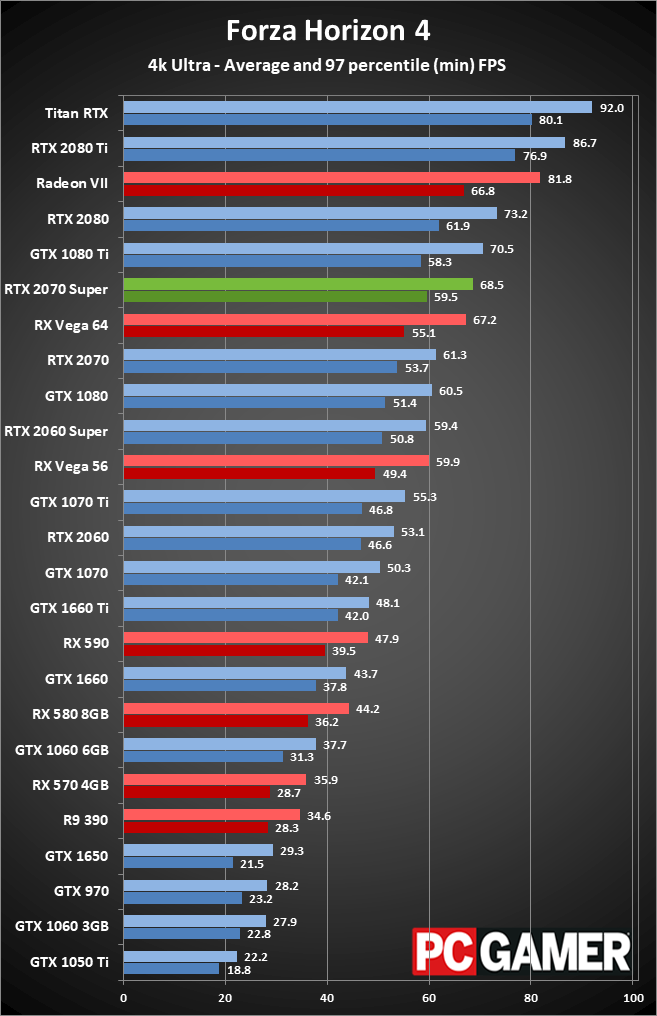

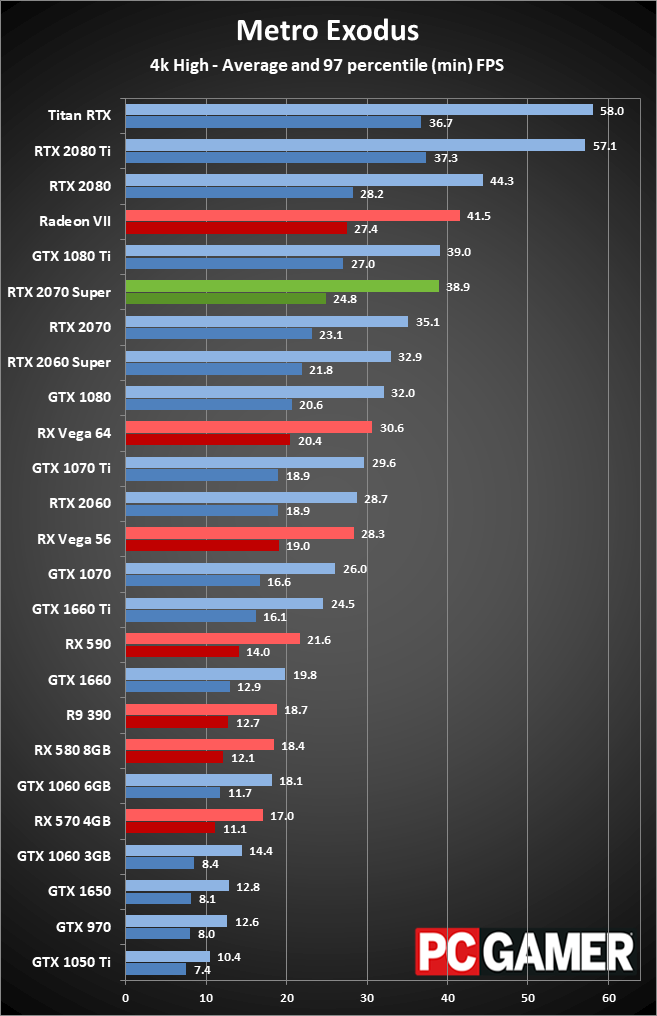
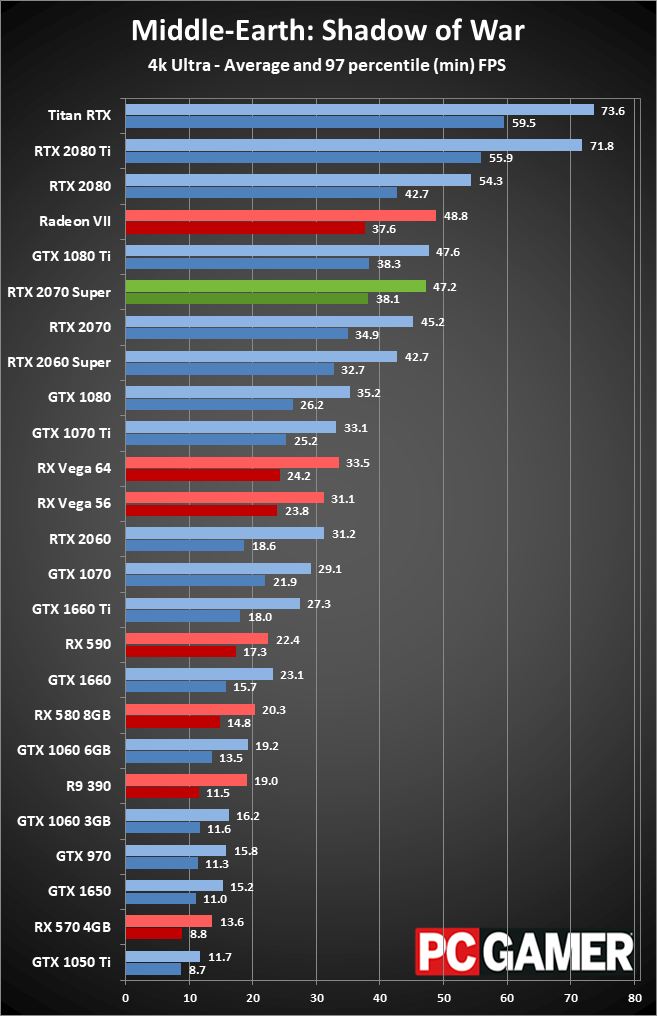
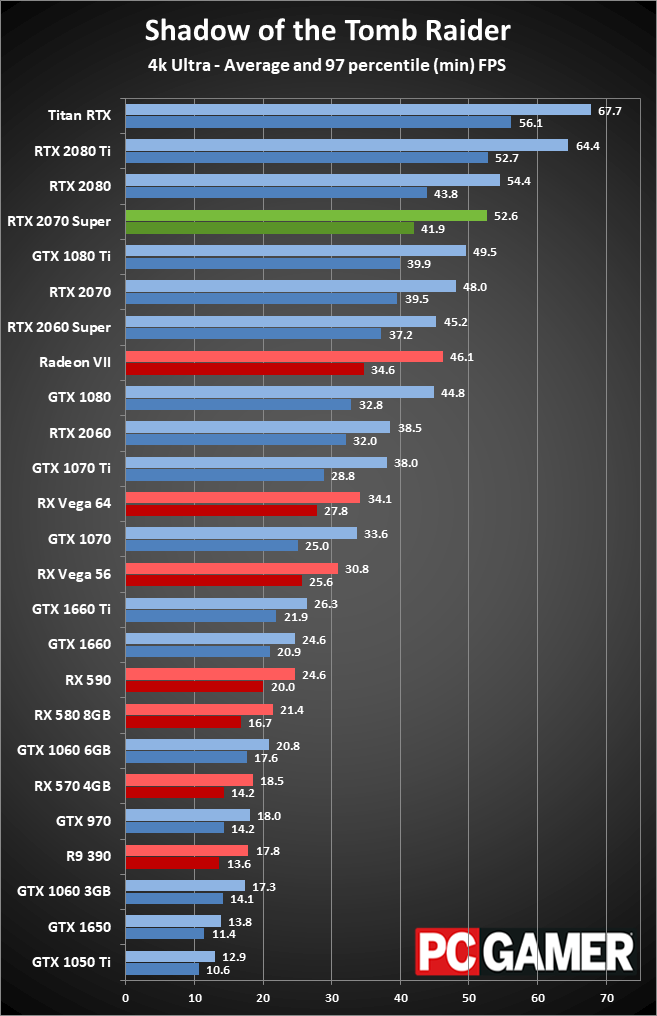
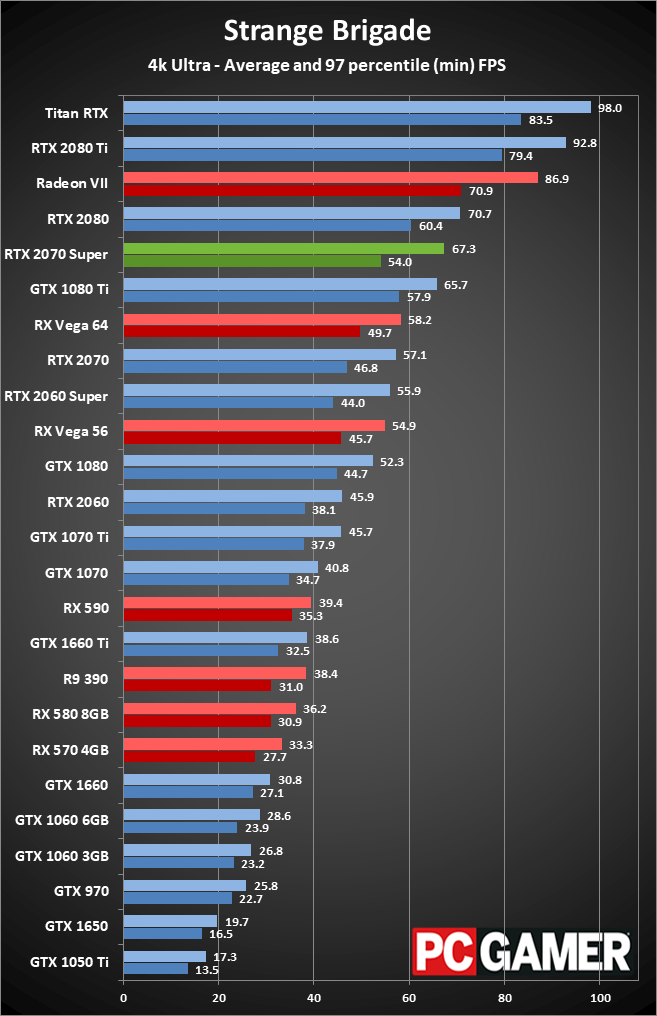
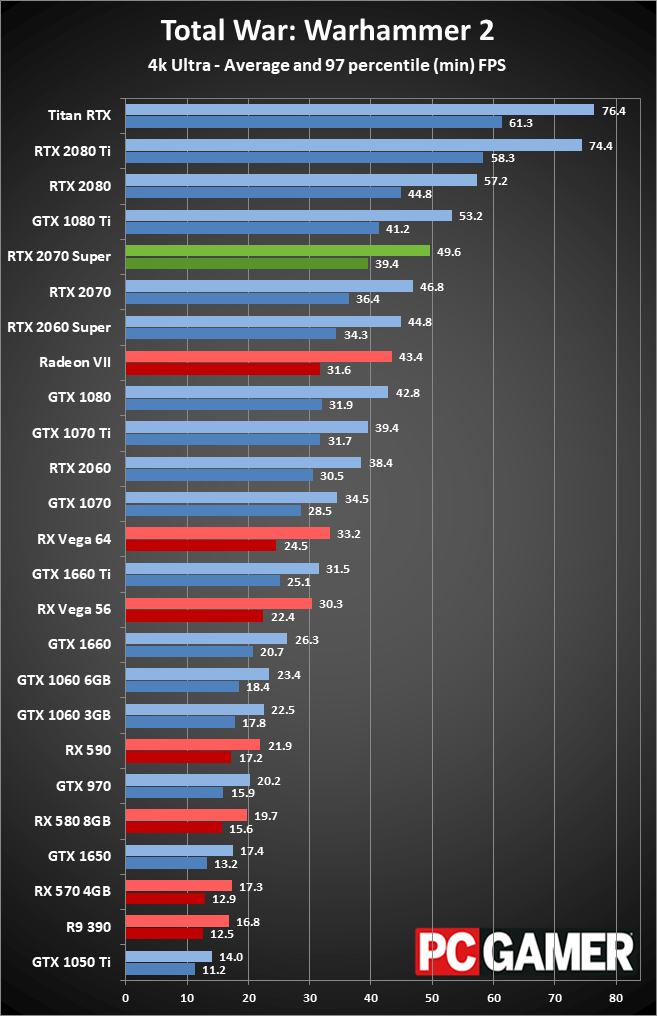
Due to time constraints and travel, as with the 2060 Super I was not able to investigate overclocking of the 2070 Super in time for this initial review. I'll update this section with additional details once I have a chance to catch my breath (after the Ryzen 3000 and Radeon 5700 launch on July 7).
Finally, at 4K ultra the performance advantage over the 2070 FE increases to 10 percent, while overall the 2070 Super, Radeon VII, and GTX 1080 Ti are basically tied for performance. There are a few cases where the 1080 Ti does come out ahead, and others where the 2070 Super leads. It's mostly a question of whether a game is more shader limited or bandwidth limited.
Not surprisingly, keeping framerates above 60fps at 4K ultra proves very difficult—not even the Titan RTX and RTX 2080 Ti can manage that feat in some games. If you're serious about gaming at 4K, you'll also want to plan on running high or even medium settings in some games if you want smooth performance.
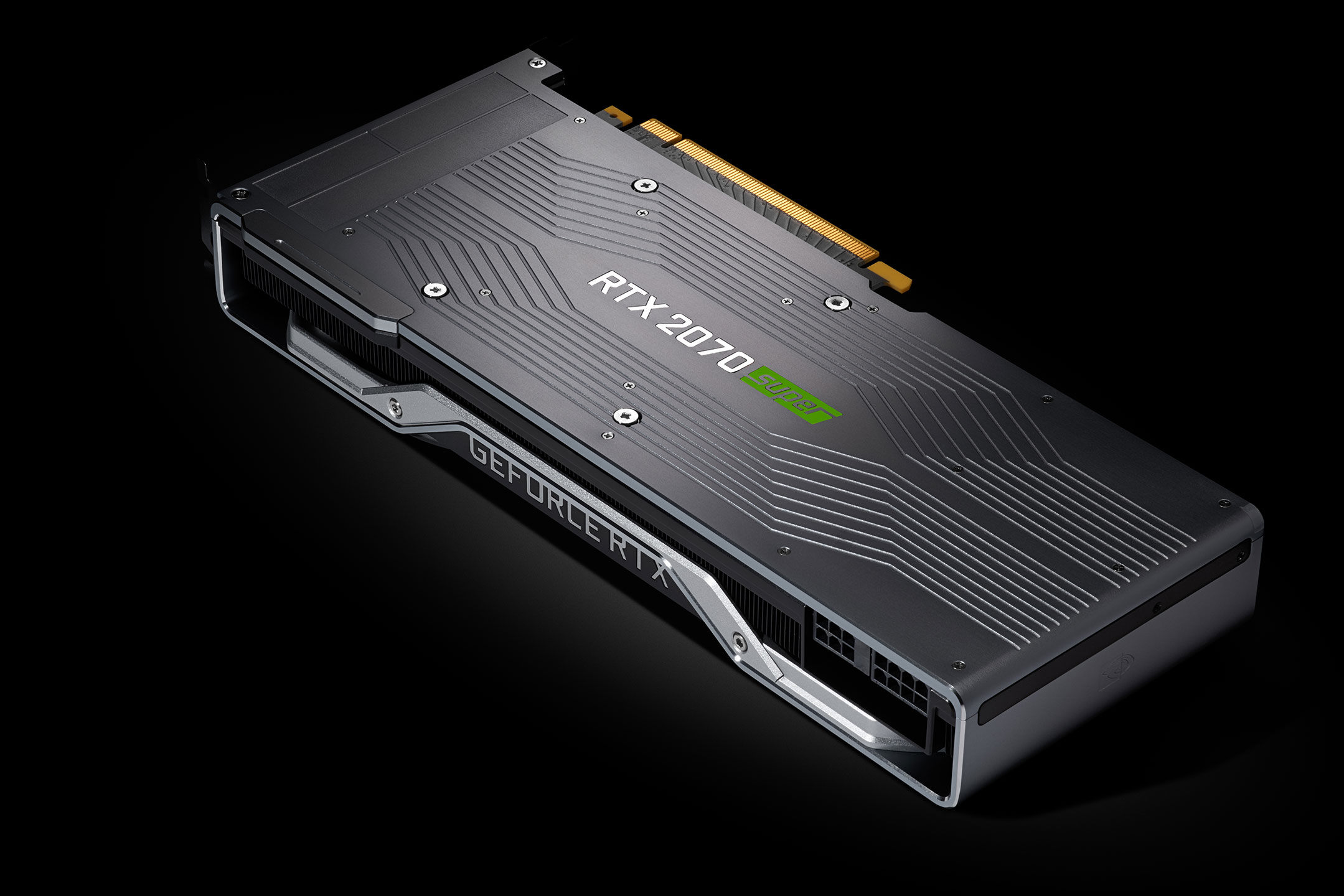
GeForce RTX 2070 Super: a modest but welcome performance bump
There's nothing too surprising about the RTX 2070 Super. Enable a few more cores, increase clockspeeds, and you get improved performance. The 2070 Super is about 10-15 percent faster than a plain old RTX 2070. It's also only 5-10 percent slower than the RTX 2080 (though the 2080 Super will change that in a couple of weeks).
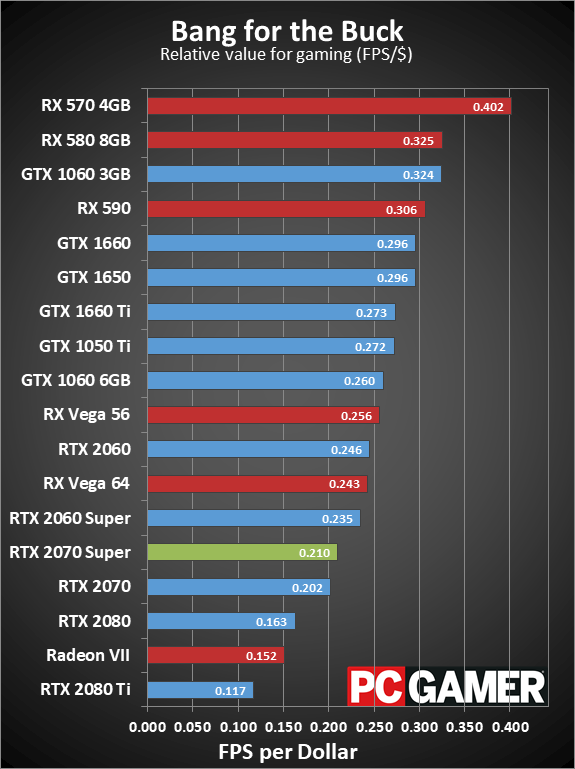
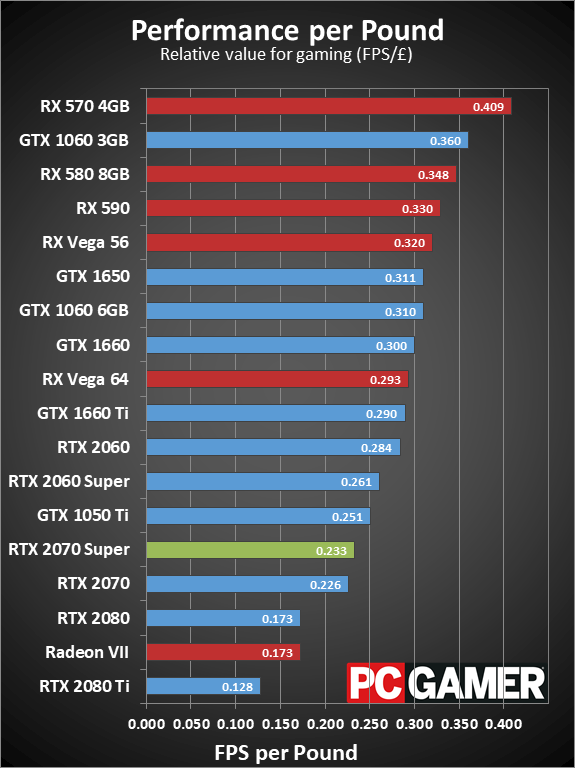
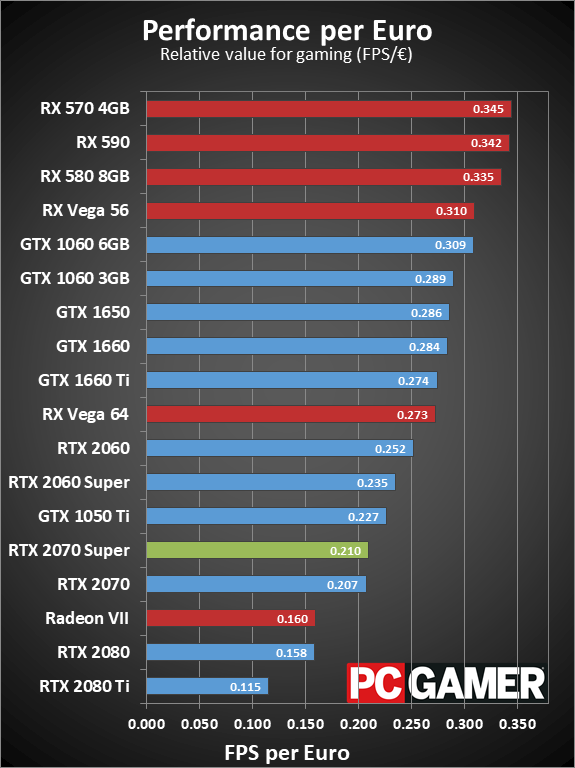
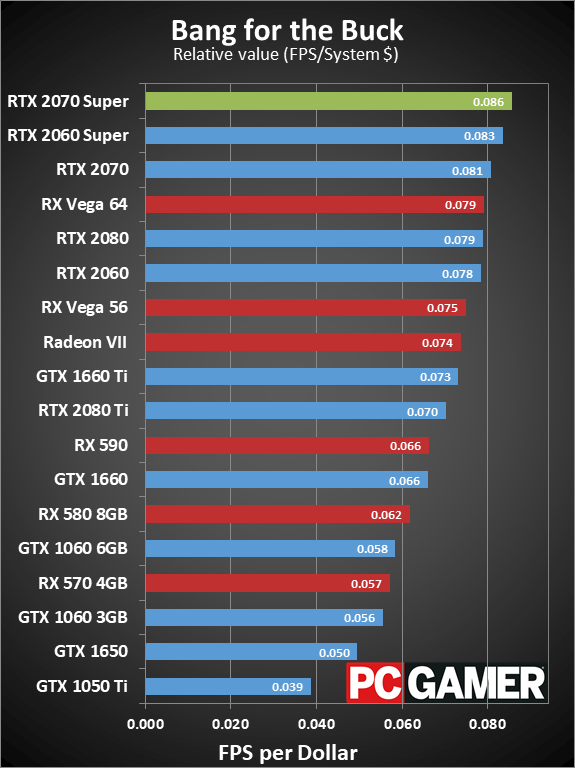
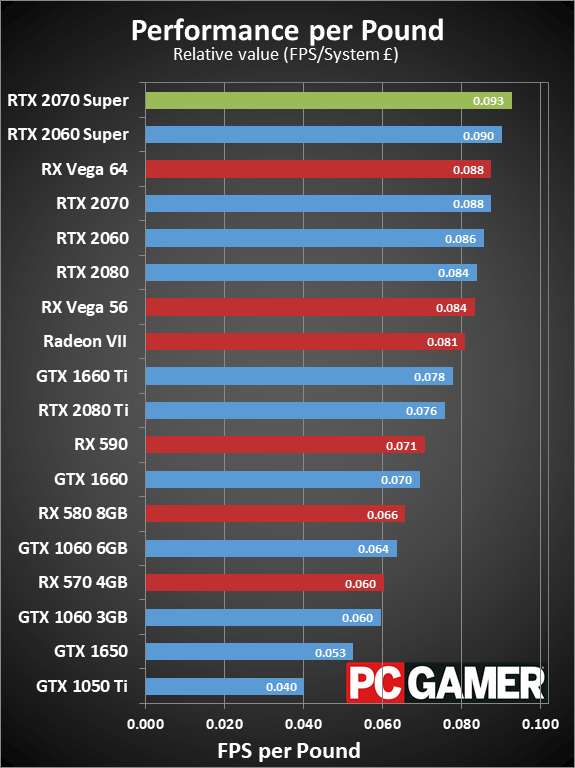
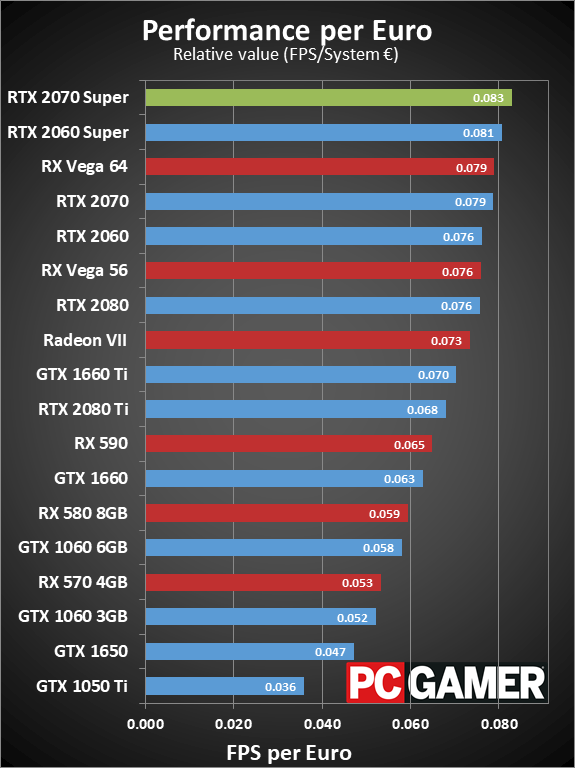
In terms of value, the 2070 Super is a great option for people looking to build a high-end gaming PC. It places at the top of the charts for the FPS per unit of money spent on a complete PC. If you're only looking at the graphics card, however, the RTX cards—and really any high-end GPU—look far less enticing. Just remember that value means many things, and even a free GTX 650 probably won't get much attention from anyone looking to play the latest games.
For those who haven't felt the need to upgrade to one of Nvidia's RTX cards already, I don't think the 2070 Super is going to change things. It's less about convincing new users to upgrade and more about ensuring Nvidia has a better card than AMD's upcoming RX 5700 series. Except, we don't know for certain how those will perform yet.
Considering AMD was claiming a 10 percent performance advantage over the RTX 2070, it looks like Nvidia will come out on top from a performance perspective. Nvidia also still wins on power efficiency, though at this point we're talking about 215W vs. 225W so it's hardly worth thinking about. The bigger issue is the future adoption of ray tracing by games and game engines. Maybe you don't think you'll ever want to play a game with DXR ray tracing effects enabled, but at least you have that option with an Nvidia GPU. With an AMD GPU, including the Navi 10 cards coming on Sunday, unless AMD has a change of heart in regards to DXR drivers, you're basically out of luck.
We're likely still years away from widespread ray tracing use within games, but the number of upcoming titles that support Nvidia's RTX cards keeps growing. If you can keep using your current card a while longer, that's almost always better than plunking down a wad of cash on a graphics card upgrade. And when the time comes to move on, there will inevitably be something better, faster, and/or cheaper.
We'll be looking at AMD's RX 5700 XT and RX 5700 performance on July 7, and the RTX 2070 Super and 2060 Super will go on sale on July 9.
The GeForce RTX 2070 Super is everything that was good about the 2070, plus about 10-15 percent more performance, at the same price.
Jarred's love of computers dates back to the dark ages when his dad brought home a DOS 2.3 PC and he left his C-64 behind. He eventually built his first custom PC in 1990 with a 286 12MHz, only to discover it was already woefully outdated when Wing Commander was released a few months later. He holds a BS in Computer Science from Brigham Young University and has been working as a tech journalist since 2004, writing for AnandTech, Maximum PC, and PC Gamer. From the first S3 Virge '3D decelerators' to today's GPUs, Jarred keeps up with all the latest graphics trends and is the one to ask about game performance.
